
Embrace the little wins. I finally got over myself and posted another video on my YouTube channel. Now that I’ve started, I must continue. Hope you like it.

Embrace the little wins. I finally got over myself and posted another video on my YouTube channel. Now that I’ve started, I must continue. Hope you like it.

 Artist Alley is part of most Comic Cons and Expos. As the name suggests, it’s a section for artists and independent creators. Each space is often a single, no-frills table, ideal for smaller budgets or those who fly to shows with only their product and a banner or two.
Artist Alley is part of most Comic Cons and Expos. As the name suggests, it’s a section for artists and independent creators. Each space is often a single, no-frills table, ideal for smaller budgets or those who fly to shows with only their product and a banner or two.
At my first Calgary Expo as a vendor in 2013, that’s where I planned to be. But a vendor I knew talked me into spending a little more money to get a Small Press booth. It had a bit more space and a pipe and drape backdrop between the booths. It was great advice, and I was in Small Press for the first five years.
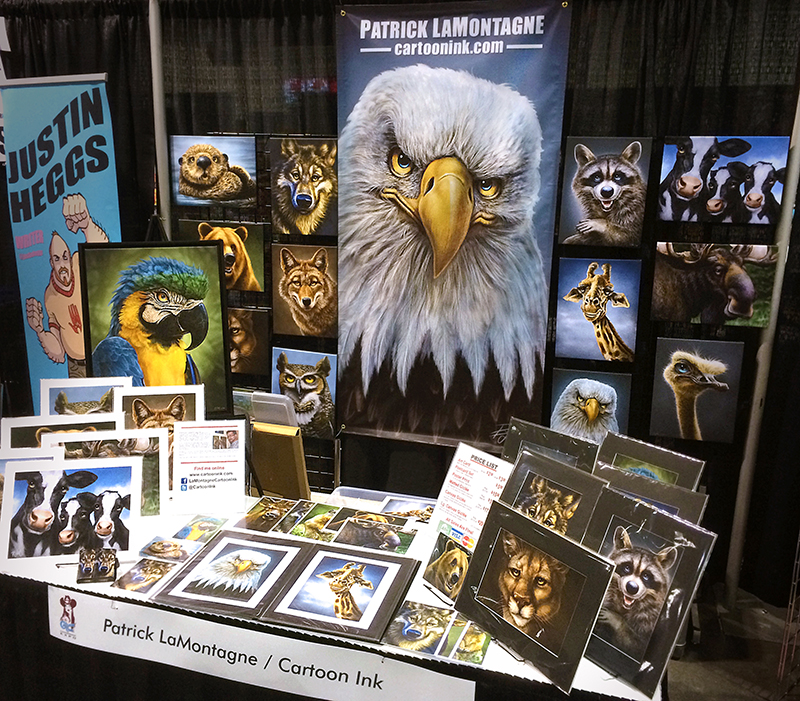 This was my first year setup, and I was thrilled I got enough sales to cover my expenses. Shonna helped me out the first couple of years, but I’ve long been able to handle this show solo. She works hard at her own job, so I don’t need her to come and do mine, too.
This was my first year setup, and I was thrilled I got enough sales to cover my expenses. Shonna helped me out the first couple of years, but I’ve long been able to handle this show solo. She works hard at her own job, so I don’t need her to come and do mine, too.
While most of these paintings are retired, a few are still popular today in prints and with licensing clients. Nobody is more surprised than me.
Shonna and I laughed this week, talking about those first years. There were no YouTube videos to tell you how to prepare for a show or what equipment you’d need. There were no pay terminals connected to our phones; it was all cash sales. You had to learn by watching other vendors, looking at their setups, and asking for advice from anybody and everybody.
Fortunately, other vendors had been where I was and freely offered tips, tricks, advice and supplier info. I do my best to pay that generosity forward when newbies ask for help.
The Expo grew yearly, and Artist Alley moved to the Big Four building. As part of that redesign, they eliminated the Small Press section. I had to decide if I wanted to step backward and leave the main building or invest in more space, equipment and inventory and become a retailer with a full-sized 10’x10’ corner booth.
To this day, I still get people asking me why I’m not in Artist Alley. The simplest answer is that I like having more space and professional pipe and drape dividers. An artist in the retail section stands out more than one squeezed in among many others. I also pay an electrical fee each year to power my lights, a service not available in Artist Alley.
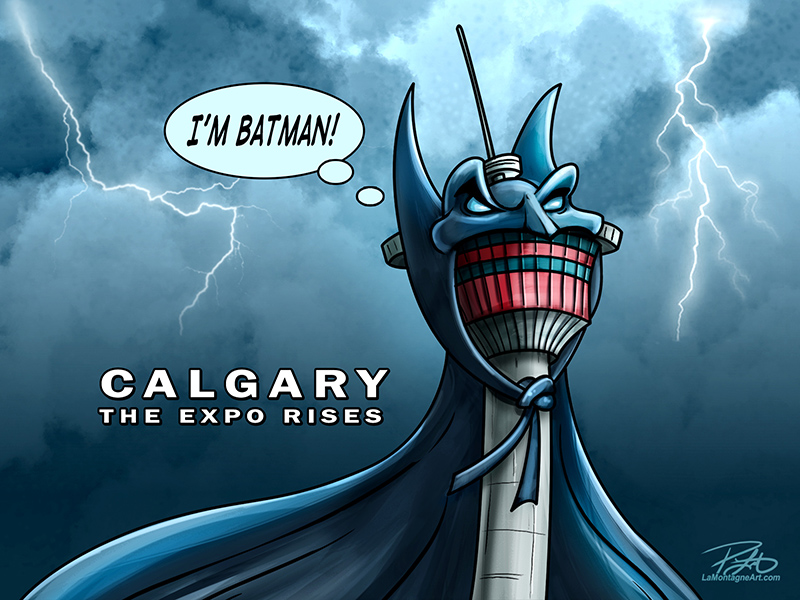 The BMO Centre has been under renovation for several years, and the show’s footprint has kept shifting. With the convention centre expansion and renovation completed this year, it’s a massive change, and Artist Alley is finally back with the rest of the show.
The BMO Centre has been under renovation for several years, and the show’s footprint has kept shifting. With the convention centre expansion and renovation completed this year, it’s a massive change, and Artist Alley is finally back with the rest of the show.
The other day, I chatted with a subscriber who works for a wholesale customer. She’s more involved in the online Expo community than I am and shared that some of the Artist Alley vendors were disappointed or upset that the show is now under one roof.
I understand their fear of change, especially if the divided venue is the only thing they know. They’re likely unaware the show only split when it got too big to contain itself. Putting Artist Alley in the Big Four building was a compromise, and back then, many were upset and disappointed at the split. This year, it’s a welcome reunion for those who remember the good old days.
As this is my tenth year, having experienced both options, I have no doubt that having the whole show back together will be an advantage for vendors and attendees alike. With no requirement to leave one building and enter another, people will spend more time in one place, which means everyone will get to see everything.
I hope the Artist Alley vendors find out it’s probably a good thing for them, and I want them all to do well.
Five days in one location means you can get to know your neighbours during the slower periods and before opening each day. I always learn something from other vendors, even if they’re new. I’ve had mostly good neighbours in my ten years of Expos, but occasional challenges have occurred.
Two years ago, a collective of three or four young women selling their costume jewelry had boundary issues. They pushed into my booth several times, threatening to knock my art off the walls. They hung out in front of or IN my booth with their friends, or they cranked up their club music, making it difficult to talk with my customers.
Last year, however, I was next to a couple of young guys from Grande Prairie who were friendly and fun to be around. They politely asked if they could hang a banner off my grid wall on their side, and I was happy to accommodate them.
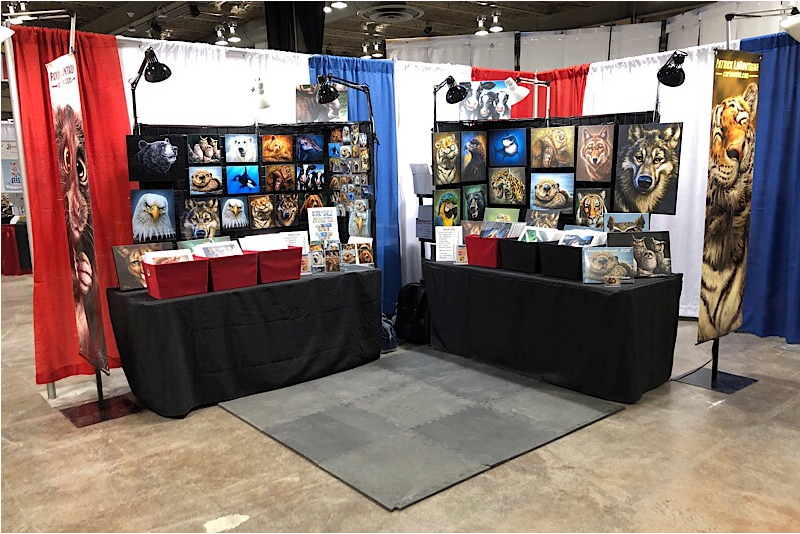 This was my booth in 2019, one of my best spots ever. During setup, the booth next to me was a no-show, and the vendor on the other side of the gap asked the organizers if he could take some of that space. They agreed. He excitedly came to me and said he’d only take half of it, and I could have the other half, a generous gesture on his part. We both expanded our booths and even had storage space between us.
This was my booth in 2019, one of my best spots ever. During setup, the booth next to me was a no-show, and the vendor on the other side of the gap asked the organizers if he could take some of that space. They agreed. He excitedly came to me and said he’d only take half of it, and I could have the other half, a generous gesture on his part. We both expanded our booths and even had storage space between us.
Another reason I loved this spot was that it was next to one of the widest aisles beside a wall and a straight line to one of the loading doors. On teardown, it was pouring rain that year. The vendors around me cleared out quickly. After I packed everything and it was time to load out, one of the show staff offered to let me bring my car inside. I parked beside my booth, loaded up comfortably, and drove out the door.
This was likely the only time that will ever happen at this show, but it sure was a treat.
The most familiar faces at the Expo are my wonderful subscribers, customers and collectors who come back year after year to support my work. I see several of the same vendors, too, but I only know a few. It’s a busy show, with 100,000 people attending over four days, so spending time outside my vendor neighbourhood is impossible.
One vendor I know has been at this show for about as long as I have. Brock is a talented scroll saw artist with pop culture and entertainment-themed work that fits this audience perfectly. We chat each day of the show, before opening, or when he and his family come by my booth to get some new prints and stickers.
Because I’m usually at the show by myself, they’ve always been so kind to offer to watch my booth if I need a bathroom break. Several of my long-time collector friends do that, too, and it’s greatly appreciated. I bring my food, so that’s the only time I need to leave my space.
This week, the Expo updated its Exhibitor List to reveal booth numbers. I was delighted to discover that, for the first time, Brock and I are next-door neighbours, our corner booths forming the end of an aisle block. What a great start to the event.
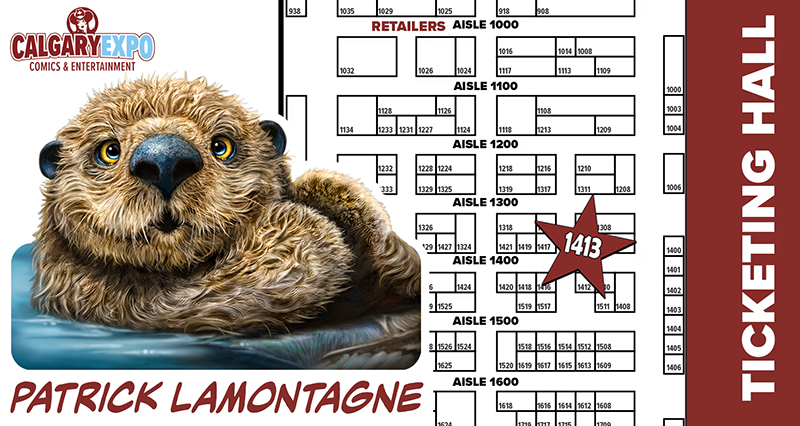 Though everything I need for Expo is here and mostly ready, I’m still working on last-minute prep and drawing editorial cartoons to keep my newspaper clients supplied while I’m away. The Monday after the show is Election Day in Canada, so I must also have that morning’s cartoon done in advance.
Though everything I need for Expo is here and mostly ready, I’m still working on last-minute prep and drawing editorial cartoons to keep my newspaper clients supplied while I’m away. The Monday after the show is Election Day in Canada, so I must also have that morning’s cartoon done in advance.
To you diehards who attend every year, I look forward to seeing your smiling faces once again.
If this will be your first Calgary Expo, please stop by and say Hello. I love seeing the shell-shocked expressions on people who have never been to this circus. You’re in for a real treat.
Cheers,
Patrick

If I were to give one piece of advice to aspiring professional artists, it would be to diversify. Find as many income streams as possible so that when one inevitably falters or fails, it doesn’t mean the end of your business.
At the peak of my editorial cartoon career, I had more than four dozen daily and weekly Canadian newspapers regularly running my cartoons in almost every province and territory. While it continues to be a valuable part of my business, today, it’s no longer the full-time income it was. But I’ve had time to pivot because I lost one or two papers at a time, with several clients instead of just one.
Thankfully, I developed another side to my business with my whimsical wildlife, which continues to grow. That revenue also comes from several different sources.
I wholesale my prints and vinyl stickers to places like The Calgary and Toronto Zoos, Discovery Wildlife Park, and Stonewaters in Canmore.
My online store is not a significant source of revenue, but my art sells well in person at the Calgary Expo and Banff Christmas Markets.
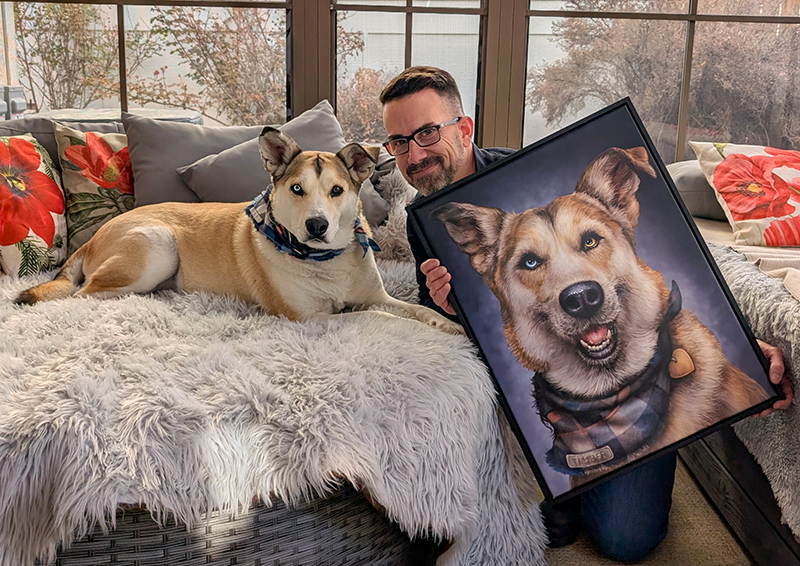 Because of the work involved and the fact that I need to leave room for painting more wildlife, I only accept a few pet portrait commissions a year, but that’s also a reliable source of income.
Because of the work involved and the fact that I need to leave room for painting more wildlife, I only accept a few pet portrait commissions a year, but that’s also a reliable source of income.
Finally, I’m fortunate that my animals have commercial appeal, and my art style is attractive to licensing clients. Companies put my art on their products and pay a royalty percentage on sales.
Harlequin Nature Graphics in Victoria has sold some of my images on T-shirts for many years. Pacific Music & Art adds my art to cards, water bottles, coasters, magnets, trivets and more. If you visit the Calgary Zoo gift shops, you’ll see my prints and stickers on shelves next to my art on Pacific products.
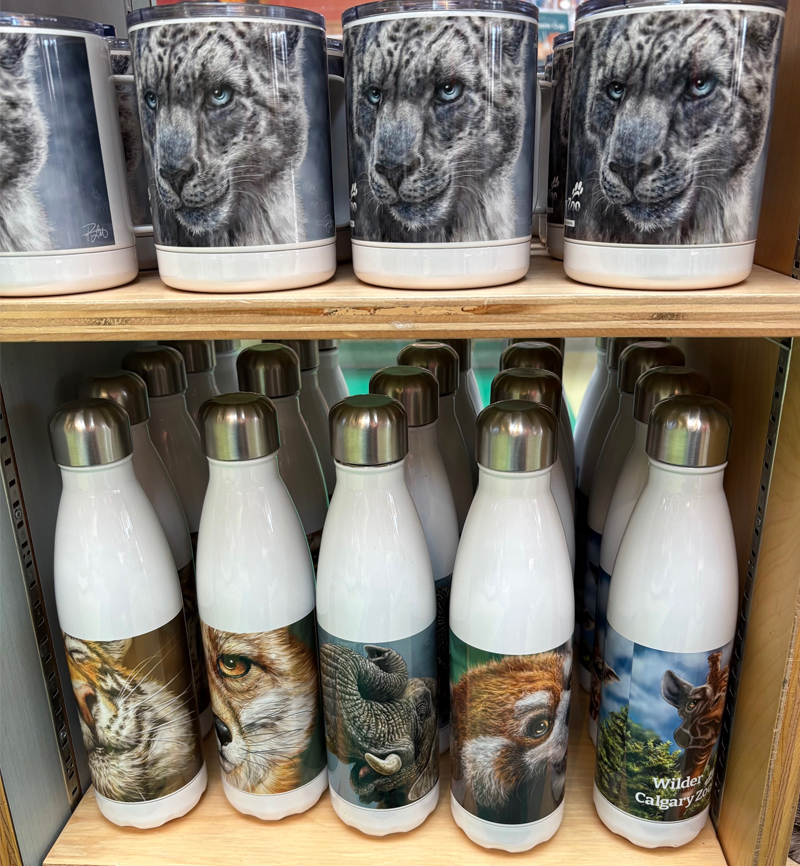 Licensing allows me to reach a much bigger audience than I could handle myself. I already spend more time promoting and selling my animal art than I do creating it. If I tried to do the work my licensing clients do, I could never paint anything.
Licensing allows me to reach a much bigger audience than I could handle myself. I already spend more time promoting and selling my animal art than I do creating it. If I tried to do the work my licensing clients do, I could never paint anything.
These businesses aren’t only in Canada. A company in Cyprus licensed my artwork for the Happy Color app, and clients in the UK and the US have licensed my work for several different products.
The current fabricated tension between Canada and the US threatens to devastate the economies of both countries. We all know why it’s happening and who is solely responsible. Whether you agree or disagree politically, you can’t argue against the evidence that this is devastating for the markets, cross-border trade and the formerly amicable and mutually beneficial business relationship between the two countries.
In acts of defiance against divisive tariffs and 51st state rhetoric, many Canadians are avoiding US products. Though it has long been our number one tourism destination, travel to the US for business and tourism has plummeted to the point where airlines have eliminated some routes to select American cities.
Every Canadian individual or company who works with or for US businesses is now in a difficult position. How do you promote these services and products while understanding and supporting the fact that Canadian customers aren’t buying from American companies right now?
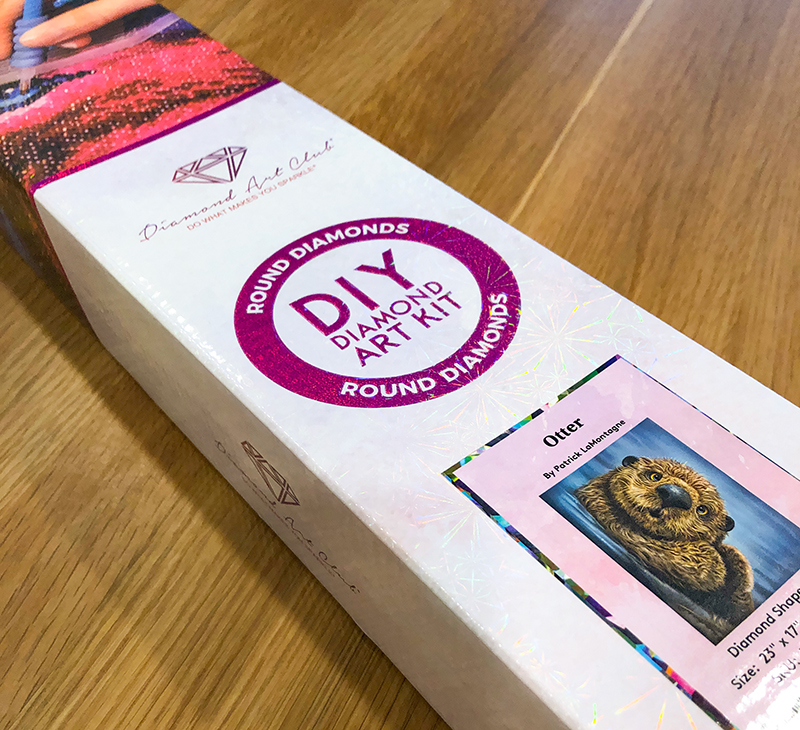 One of my favourite US licenses is Diamond Art Club. Before the pandemic, I had never heard of this hobby, but it has a massive and devoted following. The sample product they sent featuring my Otter painting impressed the hell out of me. I didn’t have time to assemble it, so I gifted it to one of my American subscribers.
One of my favourite US licenses is Diamond Art Club. Before the pandemic, I had never heard of this hobby, but it has a massive and devoted following. The sample product they sent featuring my Otter painting impressed the hell out of me. I didn’t have time to assemble it, so I gifted it to one of my American subscribers.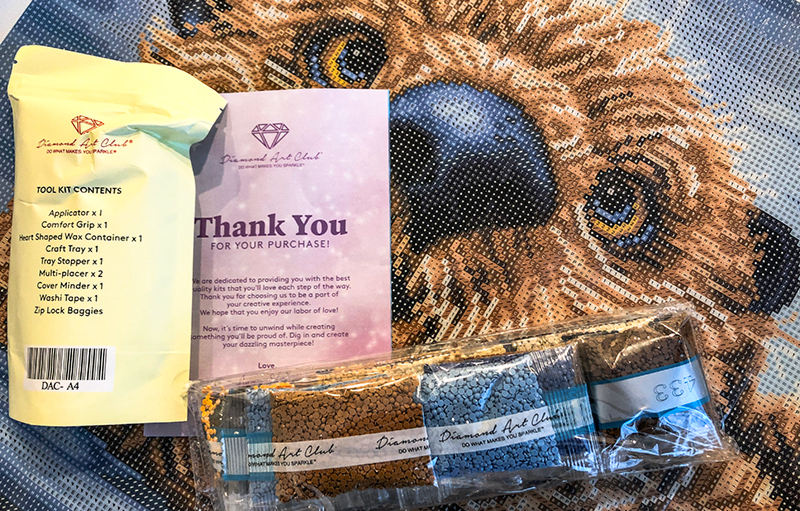
Diamond Art Club has been friendly and professional, my images sell well, and they always pay me on time. I love working with this company. In addition to the six designs they’ve got on offer, I’ve recently found out two more paintings are in the design and production pipeline.
Many years ago, I was licensed with The Mountain, a T-shirt company out of Vermont. I especially liked the connection as my French last name, LaMontagne, directly translates to The Mountain.
The owner, a talented artist in his own right, was great to work with. The Mountain sold my designs on shirts for several years. The relationship ended when the owner sold the company, but licensing contracts often only endure for a few years anyway.
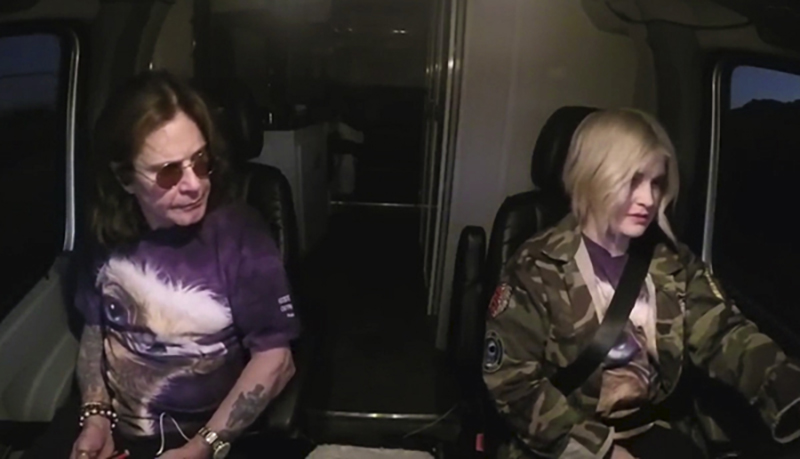 While not one of my bestselling prints, my Ostrich painting was very popular as a T-shirt, and it showed up in the strangest places. I saw Jack Black wear it a couple of times. Ozzy and Kelly Osbourne wore it on their show, as did a character in a Netflix series. Subscribers spotted the shirts and sent me screenshots from hockey and basketball games.
While not one of my bestselling prints, my Ostrich painting was very popular as a T-shirt, and it showed up in the strangest places. I saw Jack Black wear it a couple of times. Ozzy and Kelly Osbourne wore it on their show, as did a character in a Netflix series. Subscribers spotted the shirts and sent me screenshots from hockey and basketball games.
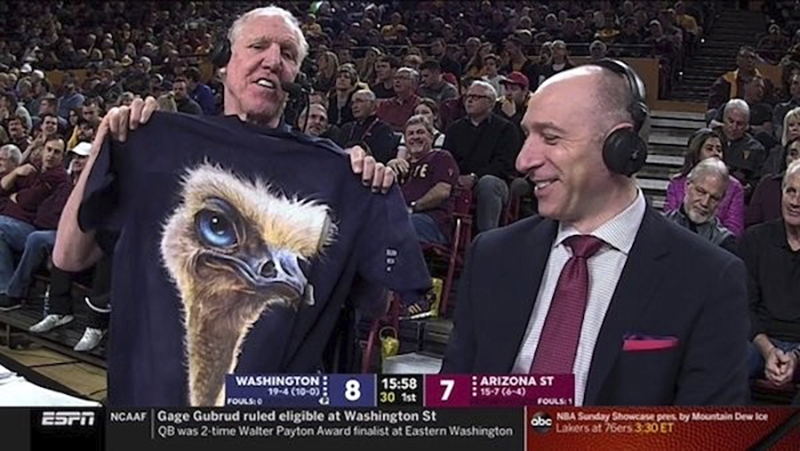 A little over a year ago, many years since our previous contract, The Mountain contacted me about licensing the Ostrich again. An ostrich ranch in Arizona sold many of those shirts, and I suspect they might have been the reason for the request.
A little over a year ago, many years since our previous contract, The Mountain contacted me about licensing the Ostrich again. An ostrich ranch in Arizona sold many of those shirts, and I suspect they might have been the reason for the request.
The Mountain was recently sold to Liquid Blue and was again under new ownership. I took the opportunity to suggest that they consider some new designs, and they were receptive.
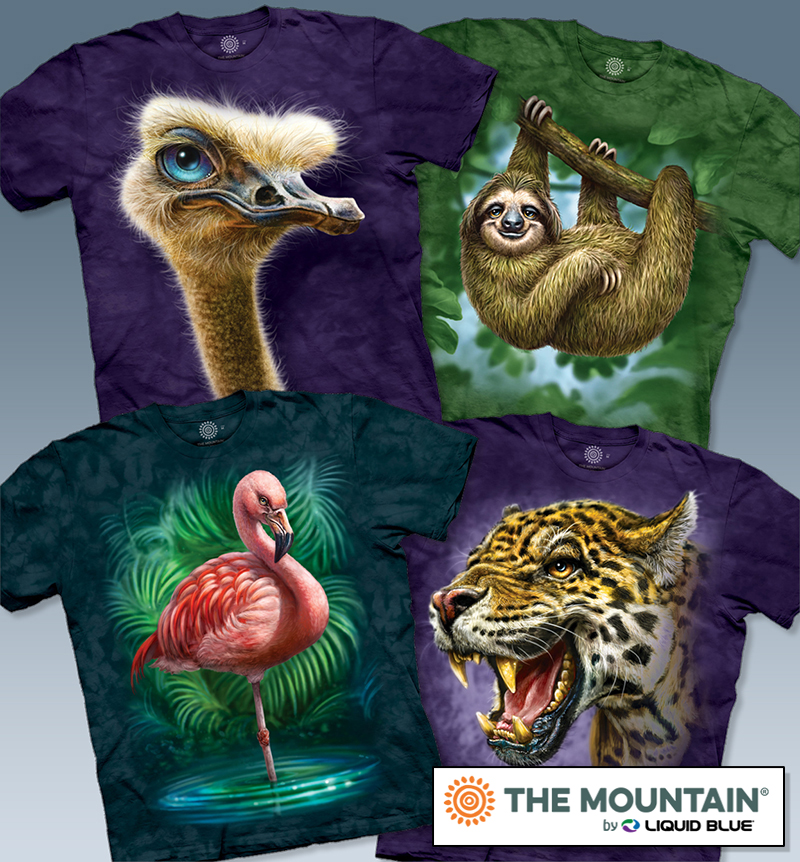 Licensing agreements can be exclusive, but many aren’t. Even then, a company that produces the same product won’t want to sell the same designs. In our online world, it doesn’t matter if they’re not in the same physical area because anybody can buy anything from anywhere.
Licensing agreements can be exclusive, but many aren’t. Even then, a company that produces the same product won’t want to sell the same designs. In our online world, it doesn’t matter if they’re not in the same physical area because anybody can buy anything from anywhere.
So, the designs I submitted to The Mountain were different from those currently sold by Harlequin Nature Graphics in Canada.
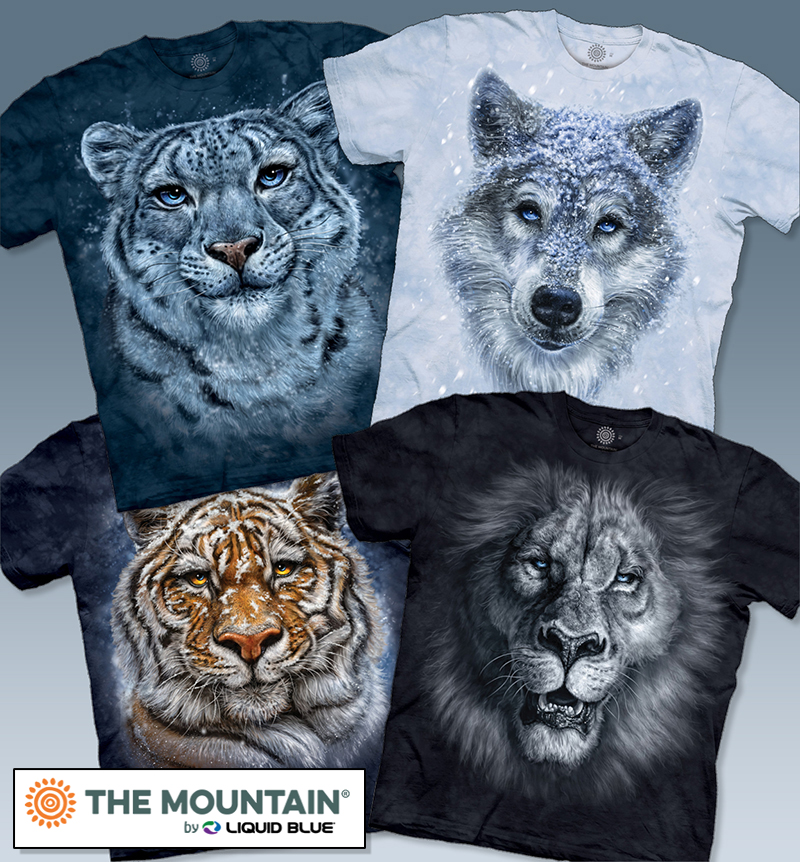 With licensing, contracts to negotiate and sign, and promotion schedules, product launches can take time. While a company plans how and when new designs are made available, it’s understood, if not explicitly laid out in the contract, that the artist doesn’t talk about it.
With licensing, contracts to negotiate and sign, and promotion schedules, product launches can take time. While a company plans how and when new designs are made available, it’s understood, if not explicitly laid out in the contract, that the artist doesn’t talk about it.
I have known these 8 new shirts have been coming for the past year. Their designer(s) did a great job adapting my images to their signature shirts, and they look even better than their previous designs.
But as bad luck would have it, these new T-shirts have launched in the middle of a trade war, where Canadian companies and consumers are actively avoiding US products, and the Canadian dollar has dropped. A year ago, I would have been excited to tell you about these designs and introduce them to my Canadian wholesale clients. But today, promoting these products to Canadians is rather pointless.
We know the situation, so I won’t go off on a political rant. We know how we got here. The fear is that there is too much damage done, and we won’t be able to get back, especially since none of this is close to finished. And just like during the pandemic, what the world looks like on the other side is anybody’s guess.
In the meantime, I will continue to adapt and diversify.

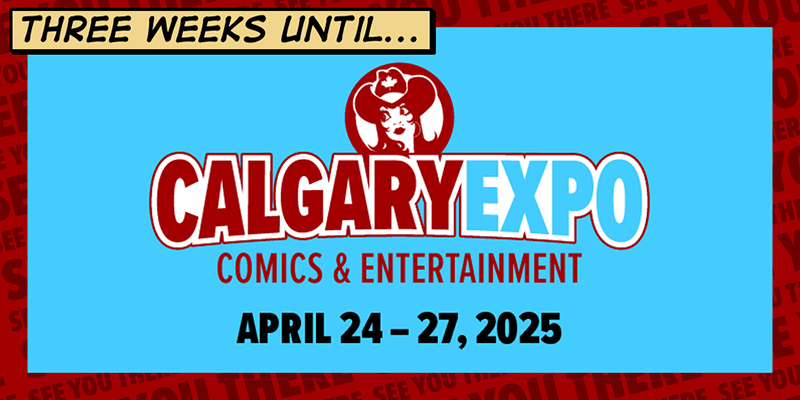 April, already. Where did the time go? The Calgary Expo is three weeks from today, and even though this will be my 10th year, I still obsess about the prep.
April, already. Where did the time go? The Calgary Expo is three weeks from today, and even though this will be my 10th year, I still obsess about the prep.
I keep detailed spreadsheets that allow me to look back on every show to see how much I sold of each item, which informs how much I order the next time. Knowing that my Smiling Tiger, Otter, and others are bestsellers is not enough. I need accurate numbers, otherwise I might order 20 of one print, though I only sold 10 the year before. Multiply that by dozens of paintings, and it soon gets costly.
Each year, I try to bring enough stock so I don’t sell out early, but not so much that I have a lot left to bring home. With tariff threats and an uncertain economy, people will still be there, but will they buy?
Late spring and summer aren’t big months for my online store, but they’re the busiest times for my wholesale clients. Because of my editorial cartoon commitments, I don’t do summer markets. So, if I have too many prints the Calgary Zoo, Toronto Zoo, or Discovery Wildlife Park don’t sell, they can sit in the closet for months. For example, none of those venues want a Raven, Orca, or Panda.
Immediately after this year’s Expo, I have two commissions on deck, one featuring three cats and another with three dogs. It’s bizarre they both arrived at the same time from different clients. Those are significant commitments and top priorities for the next few months. Both clients have been collecting my work for years and were willing to wait until May for me to start.
Sadly, I dropped the ball on a video assignment last month for a client I never want to disappoint. But I bit off more than I could chew and had to bow out. I’ve been learning a new camera setup and editing software, and editorial cartoon commitments have increased with the rapidly changing daily news, not to mention marketing efforts that have taken days away from productivity.
While the client understood and let me off the hook, it’s a professional failure I have not yet accepted.
There aren’t enough hours in the day right now, and I’m floundering.
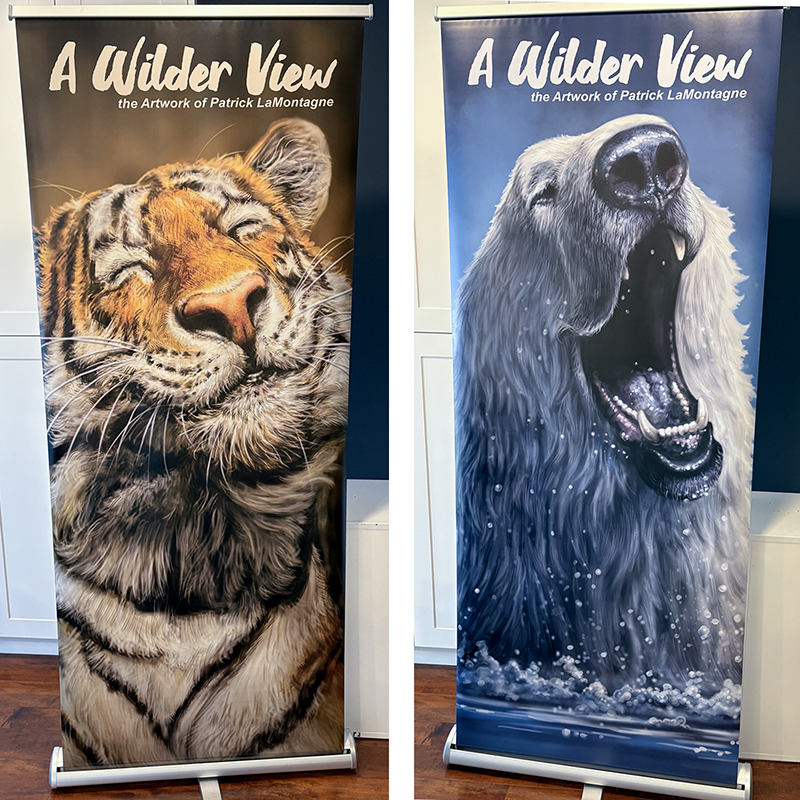 Fortunately, everything I need for Expo is already here or on the way. I placed a large print order earlier this week to fill orders for The Calgary Zoo, Discovery Wildlife Park and this event, which will arrive next week.
Fortunately, everything I need for Expo is already here or on the way. I placed a large print order earlier this week to fill orders for The Calgary Zoo, Discovery Wildlife Park and this event, which will arrive next week.
My stickers, magnets, coasters and metal prints are fully stocked for the show, but I’m waiting on tote bags. As with any new product, you learn the most from the first order.
While the first two tote bag samples arrived quickly, this much larger order took longer. It’s been five weeks, but they finally shipped a few days ago. Quality takes time, but that was unexpected. Thankfully, they’ll still arrive before Expo.
I didn’t anticipate the enthusiastic tote bag interest from all of you. Even though I asked for feedback before I ordered, inquiries have continued to come in. I checked with the company to see if I could add more to the order, and they said it wasn’t possible because they were already in production.
So, while it’s great that people are excited about them, it has presented a dilemma. I won’t have enough for the event if I offer them for sale before the Expo. The best sales are in person, and I can’t test a product at a live event if I don’t have enough to make it through the weekend. How the bags perform at Expo will determine how many I order for the four weeks of the Banff Christmas Market, which is a much more significant financial investment.
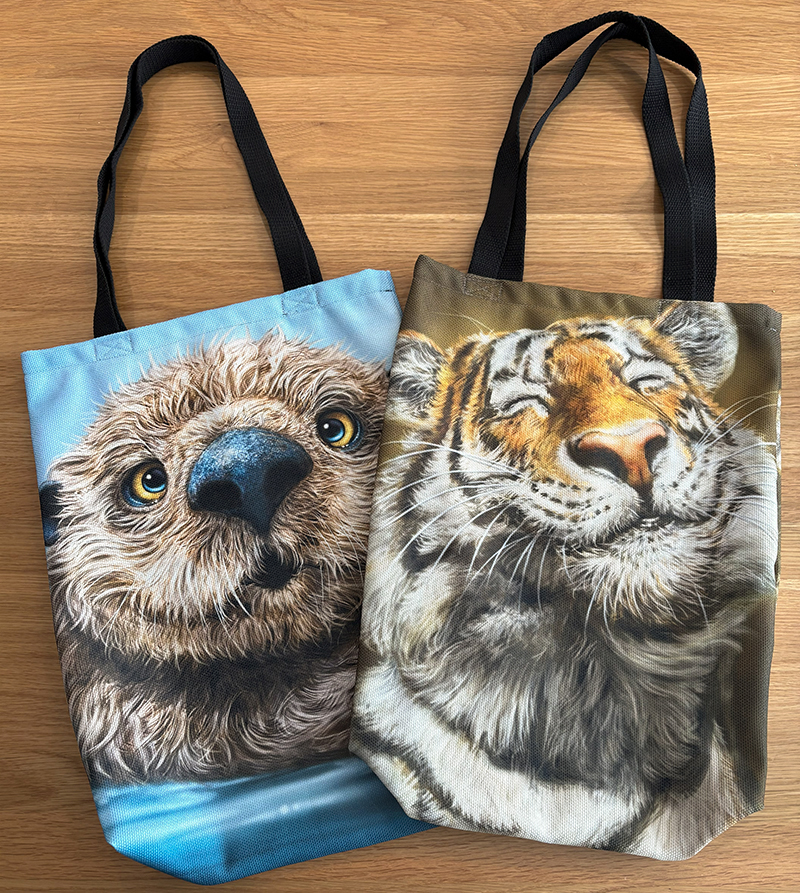 Additionally, the next three weeks will be some of the busiest of my year, and the bags won’t even be here for another week. I don’t have the room to add hours and days of shipping and delivering tote bag orders on top of all the prep and drawing cartoons.
Additionally, the next three weeks will be some of the busiest of my year, and the bags won’t even be here for another week. I don’t have the room to add hours and days of shipping and delivering tote bag orders on top of all the prep and drawing cartoons.
Creating the art is the easy part. Promoting and selling it is the work.
For those of you who have expressed interest in the tote bags, I greatly appreciate it, but I’m going to ask for your understanding and patience for a little longer. I need to take the whole order to Expo.
After the event, I’ll immediately put any remaining stock in the store and let all of you know when they’re available. If I don’t have enough to fill the demand, I’ll launch a preorder for subscribers and do what I can to add a little bonus incentive to reward your patience.
Three months into the year, I have yet to find my groove. I’m always working, but it doesn’t feel like I’m getting anywhere. Something has to give, because if there were a report card that listed all the plans, projects, and paintings in progress, there would be a big INCOMPLETE next to most of them.
I need to figure that out.
In the meantime, I’m focused on Expo. It really is a good time, and I look forward to it every year. There are so many subscribers and collectors I only see in person at this event, which is what makes it so much fun.
I’ve painted seven new paintings since the last Expo, which isn’t as many as I would have liked. But two of these paintings were a lot more work than any before, so it’s understandable. Those Grizzlies and Lemurs felt like several paintings in one. And since I will still have 39 other available images at the show, I won’t worry about it.
Stickers do well at Expo, and because so many asked for it at this event and the Banff Christmas Markets, I’m looking forward to introducing my new Highland Cow sticker.
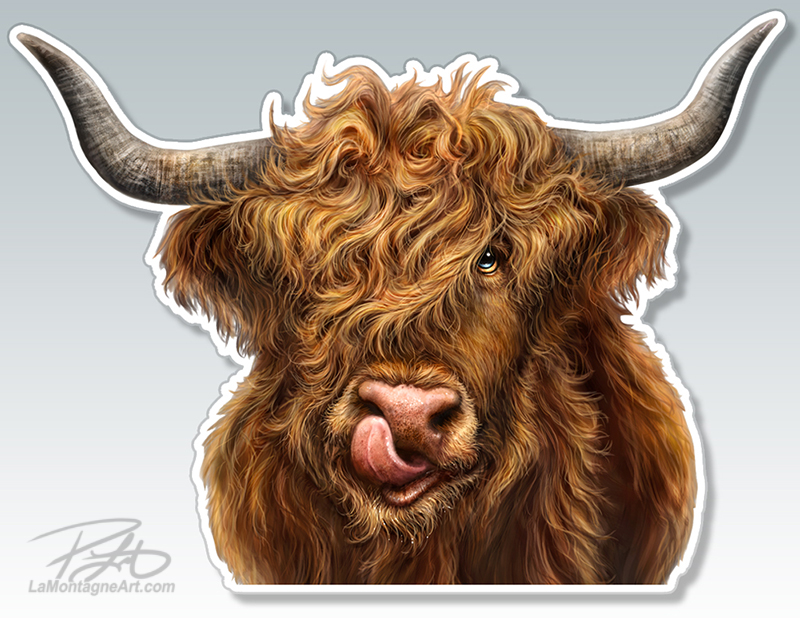 But every year, even if they follow A Wilder View, people always ask, “What’s new this year?”
But every year, even if they follow A Wilder View, people always ask, “What’s new this year?”
So, if you’re coming to the Expo but haven’t come to the Banff Christmas Markets or ordered anything online, here’s a refresher of the paintings you most likely don’t have yet. Of course, I’ll be happy to remind you in person.
Cheers,
Patrick

I’ve been drawing and painting my whimsical wildlife art for 16 years. Licensed internationally on several products, I also sell prints and stickers wholesale to places like the Calgary Zoo and Discovery Wildlife Park, in my online store, and at live events like the Banff Christmas Market and the Calgary Expo.
Most people subscribe to A Wilder View to see new paintings and hear the stories behind that work. So, it often surprises some and occasionally annoys others when I write the odd post about politics or things going on in the news. What does that have to do with funny-looking animals? Does everybody have to share their political opinion these days?
It’s usually that many people don’t know that I’ve been a syndicated editorial cartoonist for over twenty years. But if it weren’t for the political cartoons, there wouldn’t have been any animal paintings.
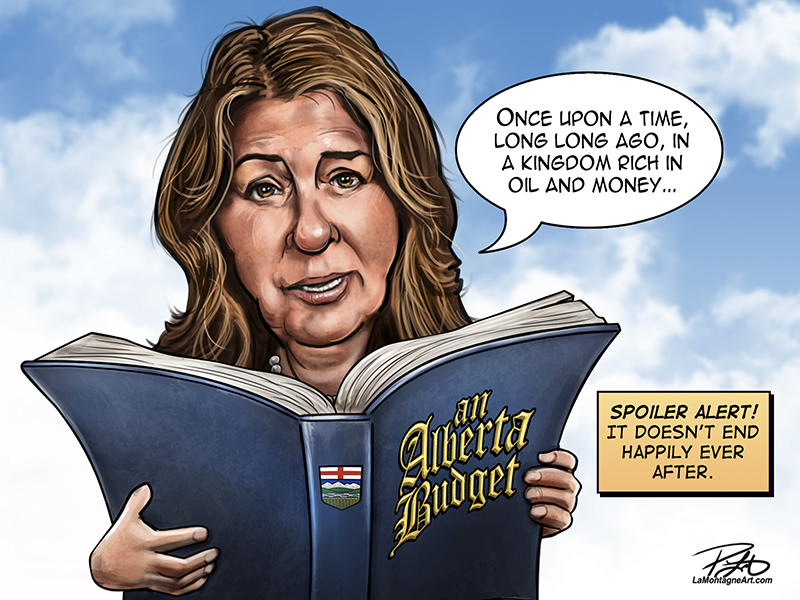 In 1998, while managing a waterslide facility at a hotel in Banff, I drew my first cartoon for the Banff Crag & Canyon. Many editorial cartoonists get into the profession because they’re political junkies who can draw. I liked to draw, and I figured I could learn to follow the news and politics if I had to.
In 1998, while managing a waterslide facility at a hotel in Banff, I drew my first cartoon for the Banff Crag & Canyon. Many editorial cartoonists get into the profession because they’re political junkies who can draw. I liked to draw, and I figured I could learn to follow the news and politics if I had to.
I was 27 at the time. I had never been to art school and didn’t know the difference between right-wing and left-wing politics. But hey, it was a small weekly paper, and $30/week gave me a little beer money.
In 2001, I was invited to join the Rocky Mountain Outlook; about the same time, Shonna and I moved to Canmore. It was an upstart weekly newspaper looking to compete with the Banff Crag & Canyon and the Canmore Leader.
Today, the Outlook is the newspaper of record for the entire Bow Valley; those other papers are gone. It is a point of pride that I have had a cartoon in every issue for 24 years. While most Outlook cartoons have a local theme, they sometimes run one of my syndicated cartoons if a local toon doesn’t work that week.
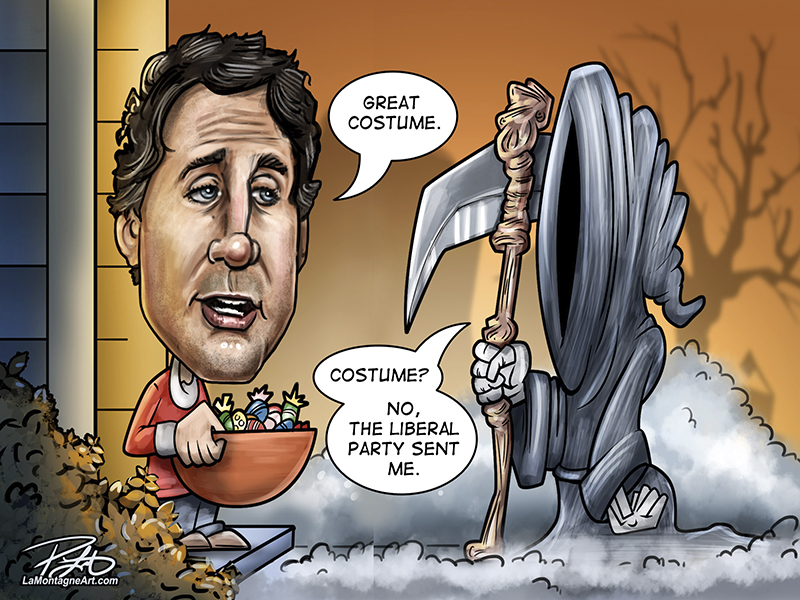 So, what’s a syndicated cartoon? I get that question a lot.
So, what’s a syndicated cartoon? I get that question a lot.
Each week, I draw five to seven more cartoons on regional, provincial, national or international issues and submit them to newspaper clients across Canada. I follow the news every day, come up with ideas and draw them. If a publication prints the cartoon, they pay me.
Many of my clients are weekly publications, and several are under monthly contracts. That means they only print my cartoons. They only need one cartoon each week, but because I also supply dailies, they have several cartoons to choose from.
While some daily newspapers still have editorial cartoonists on contract, many have a few available spots each week or only use syndicated. Several daily papers in Canada run my cartoons, but they also print submissions from other cartoonists, so it’s a daily competition.
Early in my career, I wanted a job with a daily newspaper. But as we learn in life, sometimes the best thing for you is not getting what you want. Had I got a daily newspaper gig, I would have been laid off in budget cuts years ago, a fate that has befallen many cartoonists in the struggling newspaper business.
Because syndication was always my business model, I never had to face losing my day job and scrambling to pivot. It also meant I had to draw every day, without fail, or I didn’t get paid. I learned early the discipline it takes to run your own business, that you work even when you don’t feel like it because you have to. It’s a lesson I try to share with anyone who asks for tips on making art for a living. As any self-employed person will tell you, you’ll never work harder than working for yourself.
The other benefit was that you can’t help but improve if you’re drawing daily, so my cartoons quickly got better. My early pitiful caricatures, where nobody could tell who I was drawing, became one of my best skills. I used to dread drawing real people, but now I enjoy that part of the work, even though those cartoons take longer.
Best of all, my years of learning to be a better cartoonist led to the work I enjoy most: my funny-looking animals. If I hadn’t been a cartoonist first and still somehow stumbled into painting wildlife, they wouldn’t have that ‘cartoony but real’ look that so many people enjoy.
I’ve been fortunate to receive some awards in my career, but not many. Artists only need one award to add ‘award-winning artist’ to their bio. They’re kind of like high school diplomas. Employers look for them on your resume, but how many ever ask to see one?
To think, one lie and I could have skipped those three years and started work early.
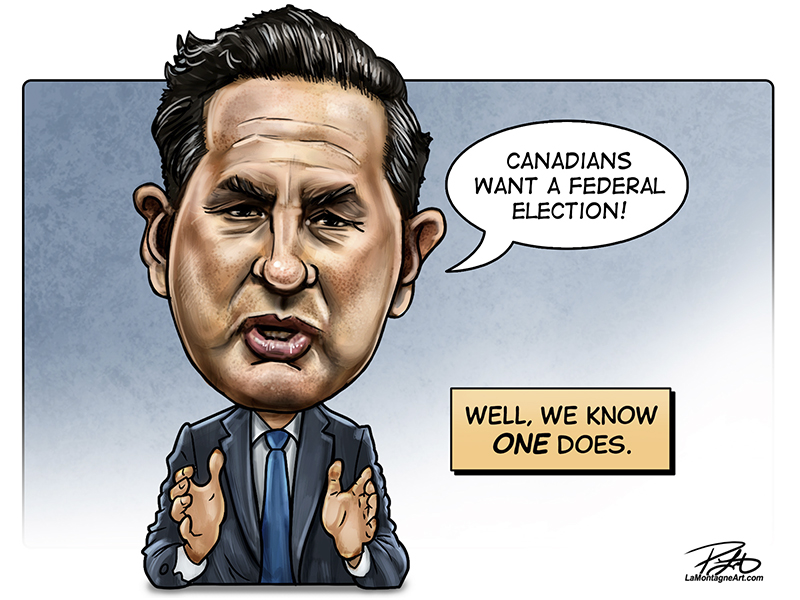 I’m most proud of the awards I received at Photoshop World Las Vegas in 2010 and 2014. The first year, I won the Illustration and Best in Show awards for some of my early animal paintings. That recognition was important to me because it was from an organization full of people I liked and respected. They were an encouraging group of talented artists and teachers, and they helped me become a better artist.
I’m most proud of the awards I received at Photoshop World Las Vegas in 2010 and 2014. The first year, I won the Illustration and Best in Show awards for some of my early animal paintings. That recognition was important to me because it was from an organization full of people I liked and respected. They were an encouraging group of talented artists and teachers, and they helped me become a better artist.
That award also opened doors at Wacom. They make the drawing tablets and displays on which I have created all my cartoons and paintings since the late 90s. I’ve worked with them several times on promotional projects over the years, and it’s been one of my favourite professional relationships.
In 2014, the last year I attended Photoshop World, I won the Best in Show award for my One in Every Family painting. The prize was the Canon 5D Mark III camera I still use today to take reference photos. Just like my car, it may not be new and pristine anymore, but it gets me where I need to go, and I will be truly upset the day I no longer have it.
That organization and event no longer exist, but it ended on a high note, and I look back on that time with fond memories. Many of those friends and acquaintances still follow my work in A Wilder View.
I have won several Alberta Weekly Newspaper Awards and Canadian Community Newspaper Awards for my local cartoons in The Rocky Mountain Outlook. The Outlook enters my work for those, and that recognition does more for the newspaper than for me. But I’ve been happy to be part of the team effort.
This brings me to the National Newspaper Awards. I think I tried to enter once in 2006 but found out I wasn’t eligible because I wasn’t attached to a daily newspaper. Sure, many dailies ran my work, but they most often sponsored their own cartoonists for the NNAs.
So, I didn’t try to enter again and figured I never would.
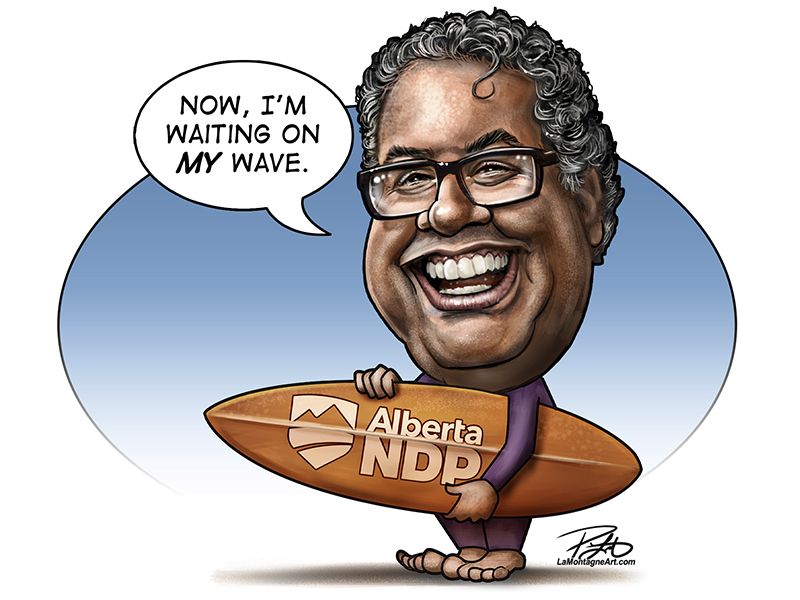 The Calgary Herald has been publishing my cartoons for twenty years. During that time, they’ve gone through several editorial page editors, and I’ve had a good relationship with most of them. But as is the case for all art, some liked my work more than others. So, some years, I might get published only once or twice a month.
The Calgary Herald has been publishing my cartoons for twenty years. During that time, they’ve gone through several editorial page editors, and I’ve had a good relationship with most of them. But as is the case for all art, some liked my work more than others. So, some years, I might get published only once or twice a month.
A change in editor at any newspaper can be the end of a cartoon contract or the beginning of a new one. They all have their favourite cartoonists, and when an editor goes from one newspaper to the other, they’ve often brought me with them or replaced me with one of my competitors. It’s the nature of the business.
These days, I’ve got a great relationship with the Calgary Herald. The now Editor-in-Chief, Monica Zurowski, has been encouraging and supportive of my work and runs my cartoons around ten times a month.
So, while the Herald does not employ me, they run my cartoons more than any other daily newspaper in Canada. Last year, Ms. Zurowski asked if they could sponsor me for the National Newspaper Awards for editorial cartooning. It was a big surprise because the NNAs hadn’t been on my radar for almost twenty years.
Because the Herald had published so many of my cartoons in 2023, I could choose five cartoons I liked from a large enough selection, and they submitted them on my behalf. I didn’t expect much, so I wasn’t disappointed when I didn’t get a nomination.
In January of this year, The Herald again asked if I wanted to submit and said they would sponsor me. The editor chose five cartoons she liked from those they’d published and said I was free to make any changes. I suggested two substitutions, and they submitted another five-cartoon portfolio for the 2024 competition. Again, I went in with low expectations. You can see those five cartoons throughout this post.
This week, I received a call from Ms. Zurowski telling me I’m one of three finalists for the National Newspaper Awards. The other finalists are Michael de Adder for his work in the Halifax Chronicle Herald/Globe and Mail and Gabrielle Drolet for the Globe and Mail.
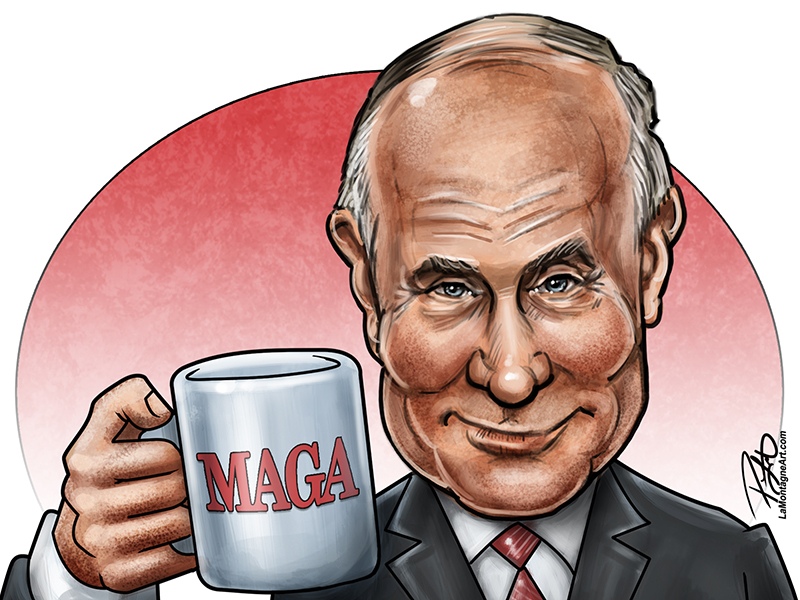 I’ve got some mixed feelings about this unexpected nomination. I’m pleased at the recognition, of course. It’s a bit of validation in a profession where I’ve often felt like an outsider.
I’ve got some mixed feelings about this unexpected nomination. I’m pleased at the recognition, of course. It’s a bit of validation in a profession where I’ve often felt like an outsider.
As someone who started relatively late in the profession, when the newspaper industry was already struggling, I often felt too far behind and that my cartoons didn’t measure up. Even when I hosted the Canadian Editorial Cartoonists Convention in Banff in 2008, I felt significant imposter syndrome. And in the aftermath of that event, of which I have no fond memories, I resigned myself to the fact that I was not part of that club. And I moved on. I have had little contact with that community since.
Instead, I have focused on the work, improving my skills, and keeping my business adaptable and sustainable. As newspapers have sold, floundered and folded, I have positioned my other artwork to take up the slack. Financially, 2018 was my best year for editorial cartooning, but each year since then, as more newspapers close, that side of my business has shown a steady decline.
Fortunately, my whimsical wildlife work continues to grow, allowing me to continue to make a good living as an artist. But I’m still drawing a local cartoon for The Outlook and five or six syndicated cartoons each week. I’m just getting paid less now for that same cartoon output.
I wondered this week if the NNA award carries the weight it used to. There are fewer cartoonists on the playing field, and some of the giants of the profession are now gone, out of work, or drawing fewer cartoons. Would a National Newspaper Award mean more to me if more cartoonists were in the race? I think so.
Or perhaps, even twenty-seven years after that first editorial cartoon became a career of thousands more, I still feel that imposter syndrome, that I never was a part of that club. Our demons never leave us, do they?
They will announce the winners of the National Newspaper Awards in Montreal on Friday, April 25th. It’s an appropriate irony that I will be very busy that day, selling my whimsical wildlife art at my biggest annual event, The Calgary Expo. It will be my tenth year at the show, introducing people to the artwork I love most, that wouldn’t have happened without newspapers and political cartoons.
Whether I win a National Newspaper Award or not, I’ll be right where I belong.
Cheers,
Patrick
One more thing
Several metal prints arrived this week for The Calgary Expo next month, the first time I’ve seen some of my newest paintings on metal. Unpacking new prints never fails to put a smile on my face as my work always looks best in print.
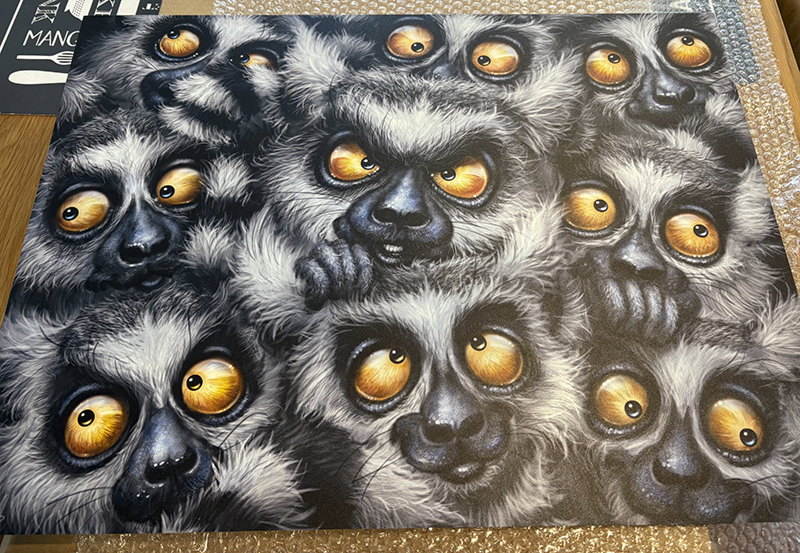 When I finished this Ringleader painting, I wrote, “I have no idea how I feel about this painting and probably won’t for a while. I feel more relief that it’s finally over than satisfaction with the result.”
When I finished this Ringleader painting, I wrote, “I have no idea how I feel about this painting and probably won’t for a while. I feel more relief that it’s finally over than satisfaction with the result.”
Just over a month later, now that the perfectionism for the piece has subsided, I can honestly say this is one of my favourite paintings. It’s so delightfully ridiculous and I laughed out loud after unpacking it. Because of the detail and so many faces, I printed it larger at 18”X24” on metal and I’m looking forward to hanging it in my booth.
As I’ll be busy every day for the next month, signing and packing new stock, organizing my booth hardware and equipment, drawing cartoons and trying to get a video recording finished, I wanted a break before all the chaos. So, my buddy Darrel and I spent four nights last weekend at the cabin we often rent in the foothills of Central Alberta.
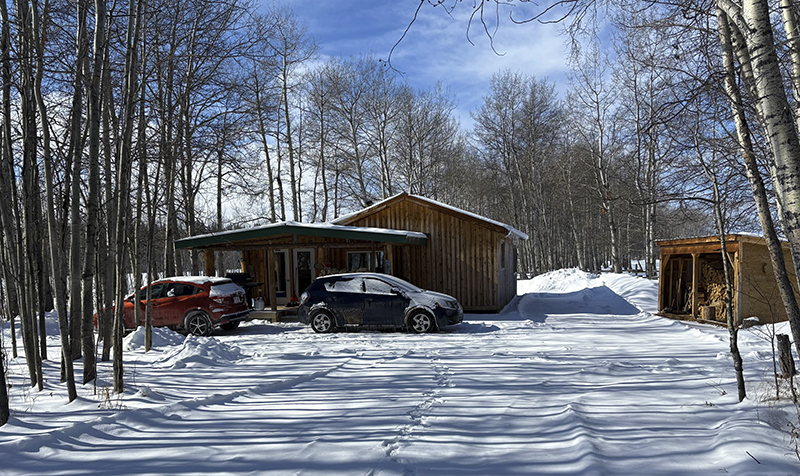 There was still plenty of snow on the ground, on the colder side of March, and we didn’t see any wildlife. But we did what greying old men like us usually do; played cards and games, went for walks around the property, napped and played guitar. This was a selfie I took for a text reply to Shonna one afternoon when she asked how we were doing.
There was still plenty of snow on the ground, on the colder side of March, and we didn’t see any wildlife. But we did what greying old men like us usually do; played cards and games, went for walks around the property, napped and played guitar. This was a selfie I took for a text reply to Shonna one afternoon when she asked how we were doing.
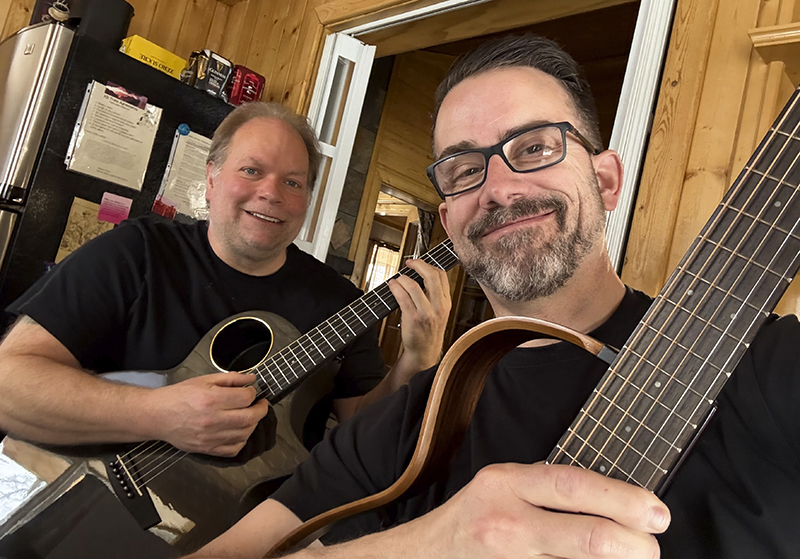 She complimented our usual black T-shirt matching ensembles. I told her I suspected she might be making fun of us, to which she replied, “Nailed it!”
She complimented our usual black T-shirt matching ensembles. I told her I suspected she might be making fun of us, to which she replied, “Nailed it!”
As I finished writing this, an email alert came in that Prime Minister Mark Carney will call a snap federal election this weekend, and Canadians will go to the polls as early as April 28th. That’s the day after the Calgary Expo, which means April just got a whole lot busier.

In the runup to the Banff Christmas Market, I had concerns. Will I have enough stock? Will I get enough sales? Will I get my editorial cartoons done each week? What if I get sick? What if the weather turns horrible?
Before I became a full-time artist in my early thirties, I worked several years in retail, tourism and office jobs. I ran a waterslide facility at a hotel in Banff for a few years. During the busy season, that place was always loud and full of people. I also managed a few retail stores in Banff for a while, so I’m no stranger to customer service work or crowded environments.
But I’ve been working at home by myself for nearly twenty years. These days, I thrive in quiet solitude. Though I’ve done the Calgary Expo every year for over a decade and the occasional holiday market around here, being ON in a public setting for a month required the reactivation of rusty skills.
In the four days between each market, I had to draw my daily editorial cartoons, update my bookkeeping, order stock, respond to client inquiries, and prepare for the following weekend. During a bit of a lull this past Saturday, I excitedly said to my market neighbours, “I get to paint next week!”
I haven’t had time to paint anything in over a month, and I’ve missed it.
It takes many hours to paint one of my animals. Sometimes, it doesn’t come together the way I want, and there’s no shortage of frustration. I wrote about that recently with the Ring-tailed Lemurs piece I’m working on. But creating the art is still the easy part. I want to problem-solve a painting, discover the solutions, and apply the lessons I learn from each piece to the next one.
However, the work surrounding the creative part takes more time than the art itself. When it’s your job, you can’t just create art; you must also sell it. Marketing and finding the products on which a particular art style works best is difficult. A product that sells well for one artist may not for another, and you only learn by trying.
My metal and canvas prints are higher-priced items that adorn the grid walls of my market booth, and those show off the brush strokes and colours better than any other substrate I sell. I don’t sell many of them because they have a higher price tag.
But they look amazing under lights, which attracts people to come into the booth in the first place. So, I need those higher-priced items to get people to stop and look at everything else. They’re products, but also advertising.
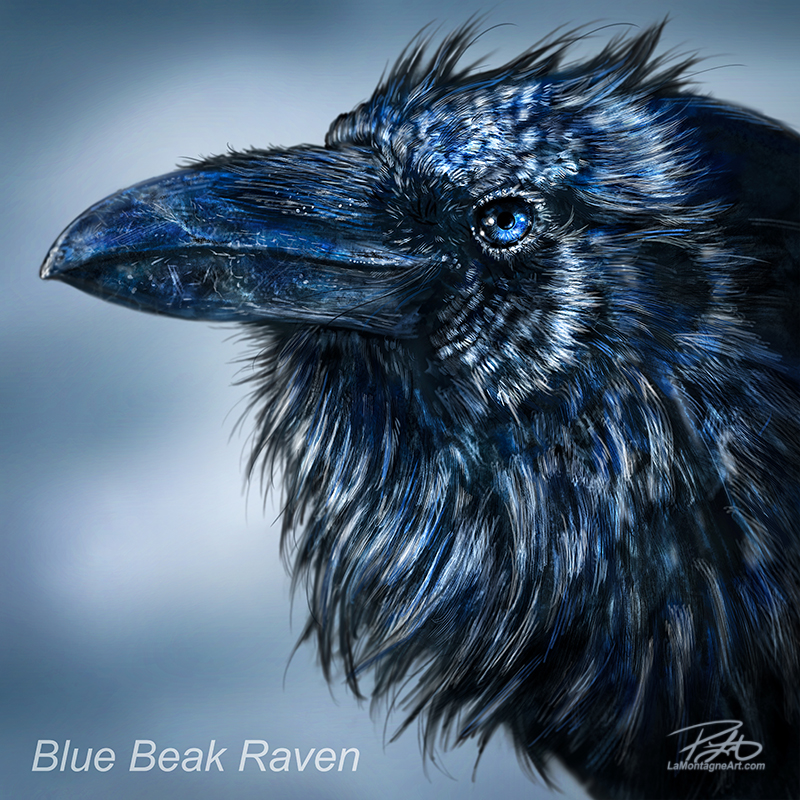 They do sell, however. I had one woman in Canmore send me an email after the market one Saturday night, regretting she didn’t buy the 16”X16” metal print of my Blue Beak Raven.
They do sell, however. I had one woman in Canmore send me an email after the market one Saturday night, regretting she didn’t buy the 16”X16” metal print of my Blue Beak Raven.
I told her I still had it; she sent me an e-transfer, and when I got to the show Sunday morning, I wrapped it and put it in my car. I delivered it to her the next day. Later that week, she sent me a photo of it hanging in her home. That never gets old.
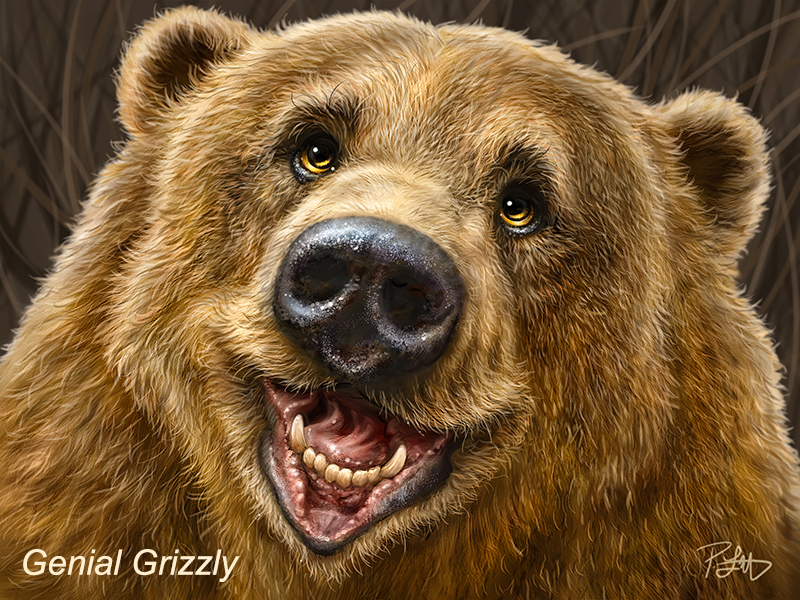 Another gentleman wanted the same size Spa Day painting on metal I had in the booth, plus a 12”X16” metal print of my Genial Grizzly I didn’t have. I said I could order and deliver the missing one to him, but he didn’t want to carry the other one around. He asked if he could pay for them, and I could order and drop both of them off in Canmore when they arrived. He wasn’t in a rush, and I was happy to accommodate.
Another gentleman wanted the same size Spa Day painting on metal I had in the booth, plus a 12”X16” metal print of my Genial Grizzly I didn’t have. I said I could order and deliver the missing one to him, but he didn’t want to carry the other one around. He asked if he could pay for them, and I could order and drop both of them off in Canmore when they arrived. He wasn’t in a rush, and I was happy to accommodate.
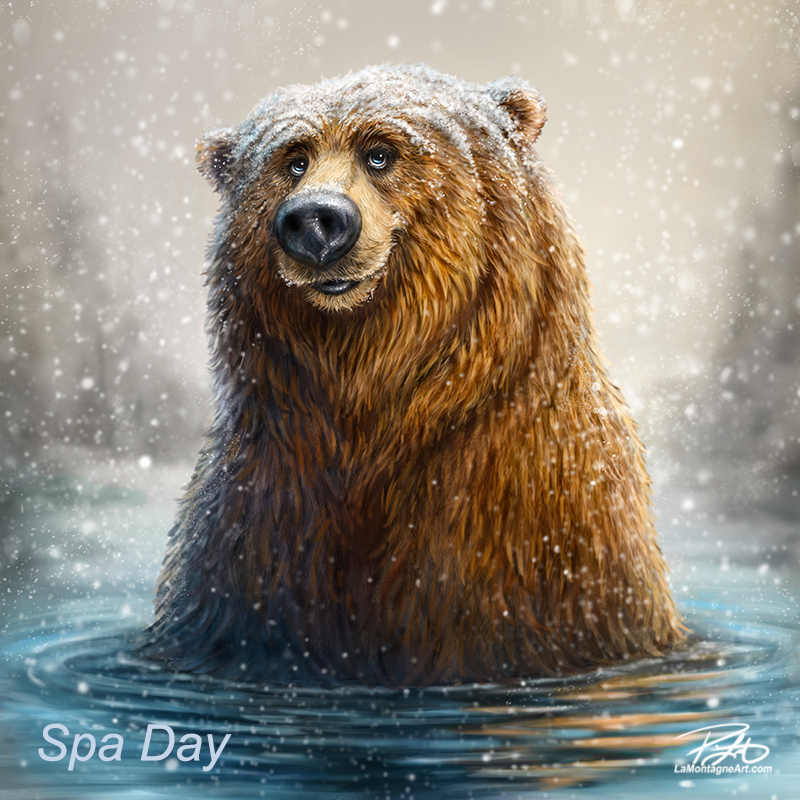 I wanted to sell the metal and canvas prints, but I didn’t want to lose Spa Day on the wall because it attracts a lot of attention. It has become a bestseller, and the metal prints on the wall sell the poster prints on the tables.
I wanted to sell the metal and canvas prints, but I didn’t want to lose Spa Day on the wall because it attracts a lot of attention. It has become a bestseller, and the metal prints on the wall sell the poster prints on the tables.
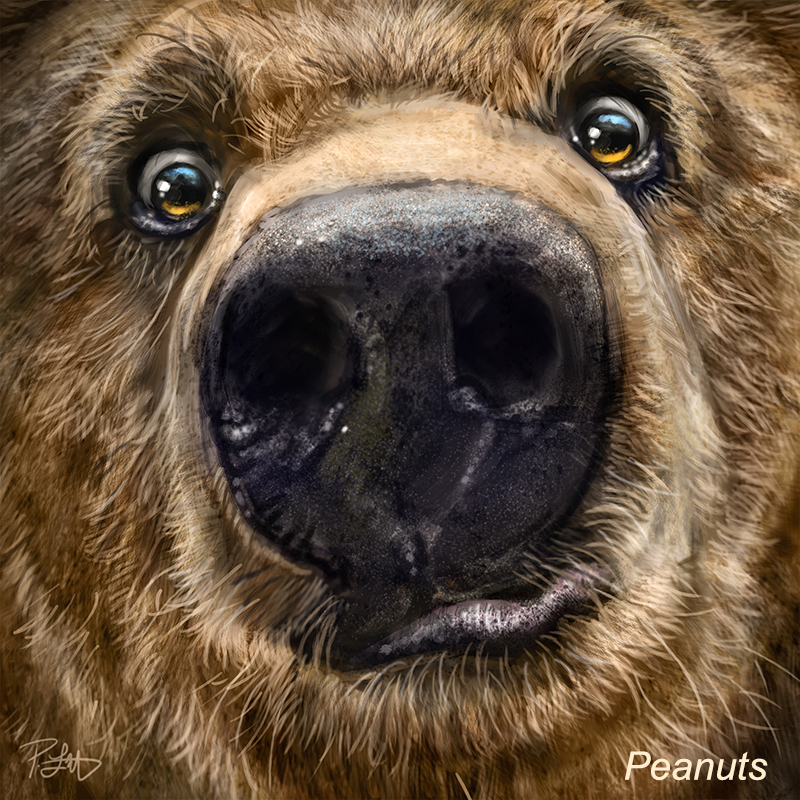 Prepare as I might; what’s true one day might not be the next. Last year, I had two metal prints of my Peanuts painting, one of my personal favourites. It doesn’t work as a poster print because it’s a square composition, so it’s only available in metal or canvas. This year, I made sure to have two metal prints on hand, and I sold them both the first weekend. So, I ordered three more for the last two weekends.
Prepare as I might; what’s true one day might not be the next. Last year, I had two metal prints of my Peanuts painting, one of my personal favourites. It doesn’t work as a poster print because it’s a square composition, so it’s only available in metal or canvas. This year, I made sure to have two metal prints on hand, and I sold them both the first weekend. So, I ordered three more for the last two weekends.
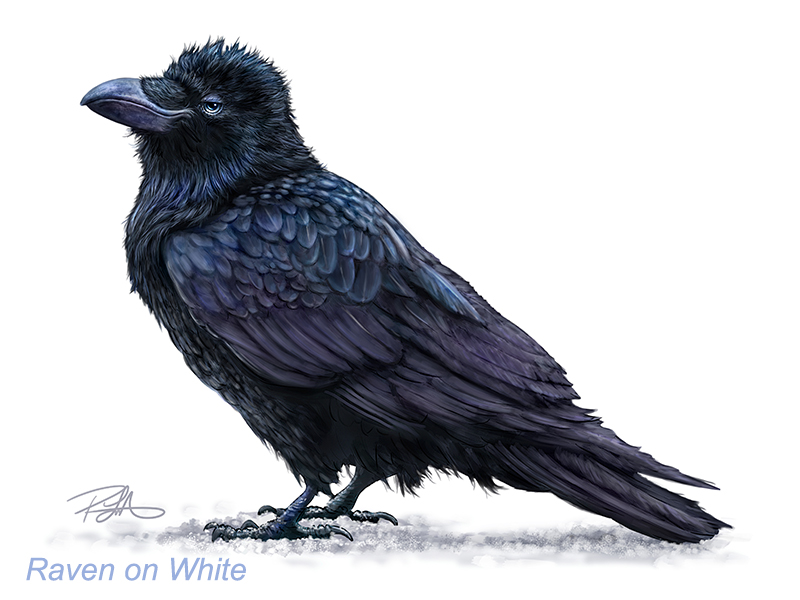 I had two metal prints of my Raven on White painting and two of my Highland Cows. I sold one of each the first weekend, so I figured I should get spares.
I had two metal prints of my Raven on White painting and two of my Highland Cows. I sold one of each the first weekend, so I figured I should get spares.
Those five metal prints arrived in time for the last two weekends, and I didn’t sell another of any of them. It turned out to be an unnecessary expense. There’s just no way to know.
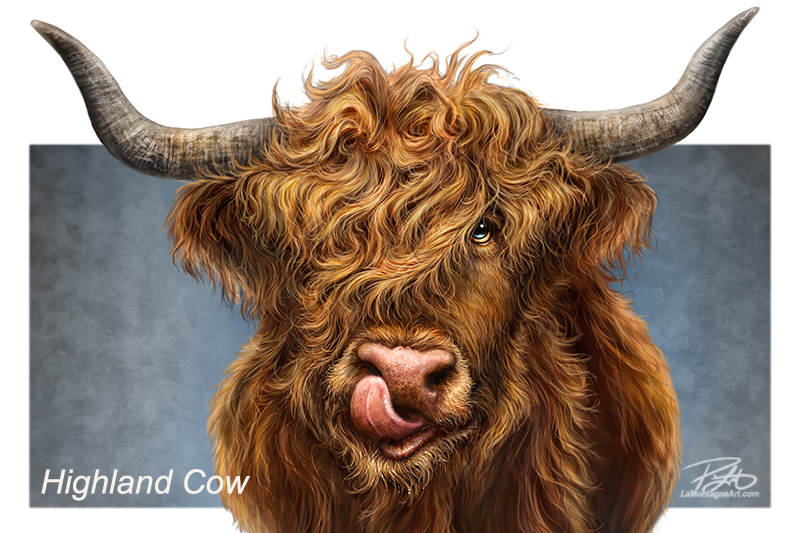 But the Highland Cow on the wall sold many poster prints over four weeks, more than any other image. The Raven on White print was also a bestseller.
But the Highland Cow on the wall sold many poster prints over four weeks, more than any other image. The Raven on White print was also a bestseller.
Thankfully, art doesn’t expire and those metal prints will sit safe and sound in their case until the Calgary Expo in the spring.
As for the other products, I sold a lot of small magnets and ceramic coasters. Those are Pacific Music & Art licensed products. Calendars sold well when I had them, but because the Canada Post strike is causing national shipping issues, I had none for the third weekend and couldn’t sell all the reorders the last weekend. As I write this post, there is no end in sight for the strike, so I have no idea when I’ll be able to sell my remaining stock. Unlike prints, calendars have a limited shelf life.
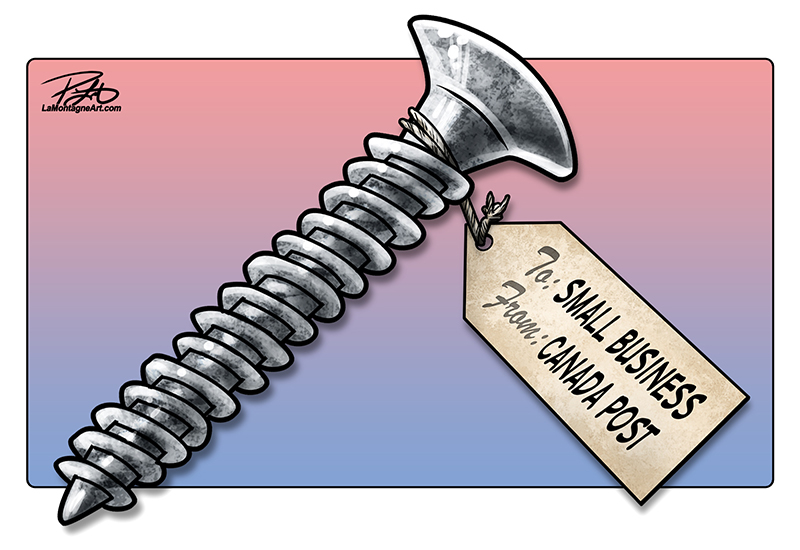
I’m very pleased and relieved that my large initial inventory of poster prints is now much smaller. Now that I have retired even more paintings, I’ll bring a leaner gallery of prints to the Expo in April, with many new paintings I’m working on and more popular and proven sellers than ever before.
What about my initial worries about four weeks of the Banff Christmas Market? For the most part, I had enough stock. When the Highland Cow prints sold out way too early, Art Ink Print in Victoria had my back and quickly resupplied me. Those continued to sell well the whole show. When I sold out of calendars and Highland Cow magnets, Pacific Music and Art did their best to deliver, though courier shipping delays threw a wrench in the gears, and those arrived later than I needed them.
As usual, I got my editorial cartoons done. Most of my newspaper clients don’t even know about this larger side of my business. Then again, many people who know my animal art don’t know about my editorial cartoons.
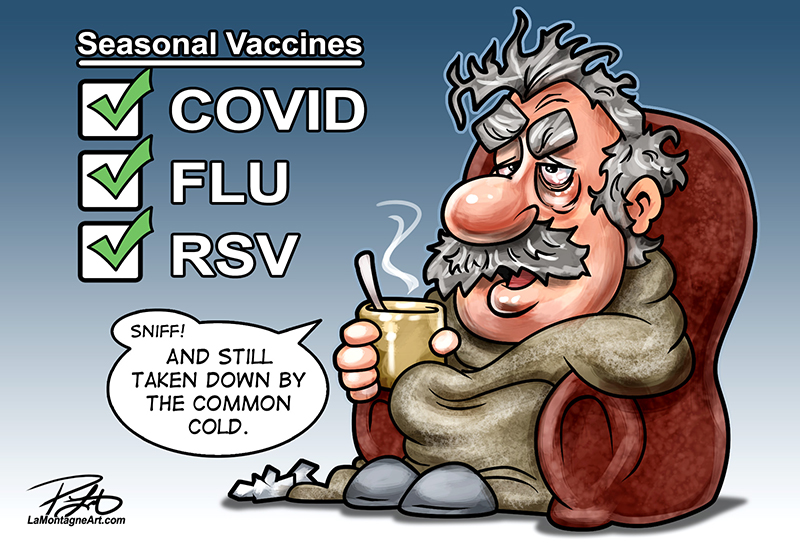 I had made sure to get my flu and COVID boosters before the markets, but still ‘got sick,’ knocked on my ass by a cold in between Weekends 2 and 3. If you wonder where I get my cartoon ideas, life inspires art. But just like everybody else who gambles with seasonal viruses, I handled it. Inconvenient, uncomfortable, but manageable. And though I began that third weekend still suffering and wearing a mask for a day, it was my second-best sales weekend.
I had made sure to get my flu and COVID boosters before the markets, but still ‘got sick,’ knocked on my ass by a cold in between Weekends 2 and 3. If you wonder where I get my cartoon ideas, life inspires art. But just like everybody else who gambles with seasonal viruses, I handled it. Inconvenient, uncomfortable, but manageable. And though I began that third weekend still suffering and wearing a mask for a day, it was my second-best sales weekend.
The weather was only horrible once when I had to drive home in a whiteout on frightening roads. There were a couple of icy mornings/evenings on the highway when a Chinook wind delivered rain around the freezing mark. But that’s just driving to work in Canada.
As for sales, I’m happy. The significant expense of booking the booth, insurance, ordering more stock than I’ve ever had, and gambling on such a large event paid off.
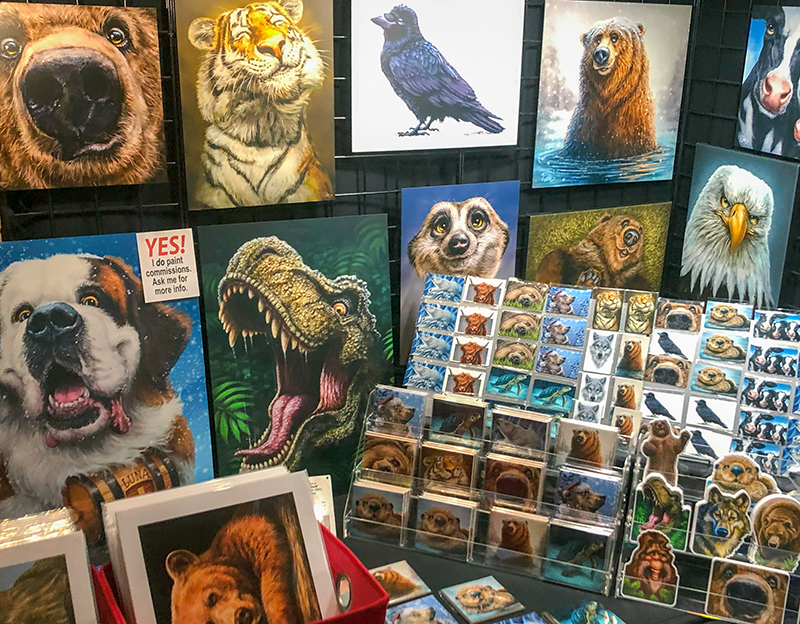 I regret I have no decent photos of my booth. The bright light on the artwork looks great in person, but my older iPhone camera just can’t seem to compensate correctly, even with an accessory filter. It’s no doubt a user problem.
I regret I have no decent photos of my booth. The bright light on the artwork looks great in person, but my older iPhone camera just can’t seem to compensate correctly, even with an accessory filter. It’s no doubt a user problem.
The new venue at The Banff Train Station was terrific. I was happy with the booth location and had a lot of fun with my neighbours. It was nice to have coworkers again, for a short time. While telling Shonna some of the funny stories, of which there were many, she laughed and said we sounded like a bunch of carnival workers.
She wasn’t wrong.
The organizers and staff put on a great show; I have no complaints or critiques. Challenges happen at every event, but this dedicated group handled them well, and I commend their efforts. Applications for Banff Christmas Market 2025 aren’t until February, but I’m ready to do this again next year for all four weeks if they’ll have me.
Finally, thanks to all of you who came to see me at my booth. Some subscribers even drove out from Canmore, Calgary, or other parts of Alberta because they had read my posts about the market. It was great to see you, and I’ll see several of you again in April at the Expo.
I added a lot of new subscribers to A Wilder View and hope you new people enjoy following my art and the stories behind it. Thanks for taking some of my work home with you or buying it for gifts. Each year, more people tell me they have one or more of my funny-looking animal paintings. They’ve bought them at The Calgary Zoo, Discovery Wildlife Park, or in one of the many retail stores in Canada selling products made by my licensing clients.
Many have bought the art directly from me at the Calgary Expo or previous Christmas markets. You all say the nicest things and pay me the kindest compliments. I’m never comfortable with that, but I’ve learned long ago just to say Thank You.
Face-to-face time with people who enjoy my work never fails to refill the creative tank. I can’t tell you how fulfilling it is to see my silly little critters make people smile or to hear how happy they make you.
So far this week, I’ve been busy drawing cartoons, doing the bookkeeping, organizing my booth hardware and products and putting it all away for a few months. I’m tired and ready for a break, looking forward to quiet time alone, with tunes in the earbuds, fresh hot coffee, and uninterrupted hours painting little hairs on smiling faces.
Art-for-a-living is a lot of work, but your support makes it well worth it. Thank you.
Cheers,
Patrick

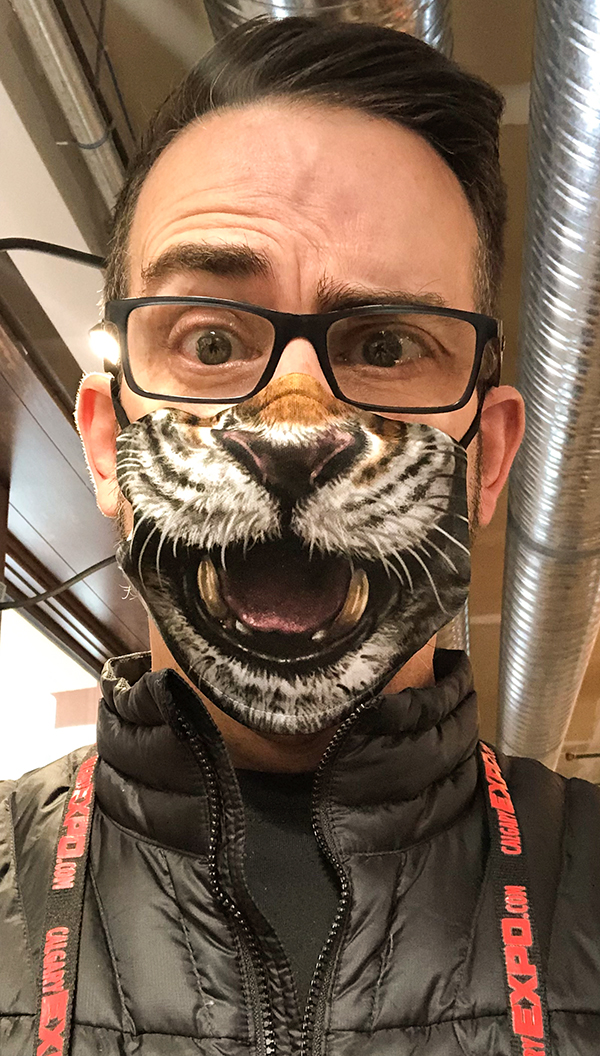 Last week was a challenge.
Last week was a challenge.
Of all the things I didn’t want to bring home from the Banff Christmas Market, the common cold was near the top of the list. I don’t get sick often, but when I do, it’s usually a full beating of a man cold. This one wasn’t fun, but it was better than most, and I had a few days to lay low at home before the third market. I felt a lot better on Friday but was still symptomatic, so I revived one of my tiger masks to prevent spreading the fun.
When I could tell people couldn’t hear me well and I had to speak up, I apologized and explained why I was wearing the mask. Some said they appreciated my not wanting to spread my cold. Others thought I was wearing it as part of the animal theme. I got many compliments, and somebody even asked if I was selling them.
I had ordered some replacement metal prints that sold the first weekend, and they were supposed to be here by Friday. On Tuesday, after Purolator said the package had arrived at the sorting facility in Calgary, they revised their tracking to say the package was delayed due to weather.
Vendors and attendees from Calgary said the roads were great, and I could find no evidence of a weather issue on that route, especially not one that lasted three days.
Many people are experiencing delays as the couriers deal with overflow and increased demand. The Canada Post strike has screwed up shipping all over the country at the busiest time of year. But when people are already pissed off at a situation, don’t lie to them. It’s insulting.
The Purolator package arrived at my door Sunday afternoon. I’m glad the weather finally cleared up.
Mike at Pacific Music & Art cobbled a rush order of Highland Cow magnets and calendars so I would have them for the last two weekends. UPS said they’d be here by Friday but that morning, they revised their tracking to, you guessed it, Monday.
I had ordered enough replacement stock for two market weekends. I now need to move them in one. As of Saturday morning, I had three calendars left, and those went quickly.
Despite a slow start on Friday, it was an excellent weekend for sales. As I’ve now sold out of a few prints, I’m retiring some to make room for new paintings next year. Others I’ll wait to restock until just before the Calgary Expo. These are some of the immediate retirees but more are coming.
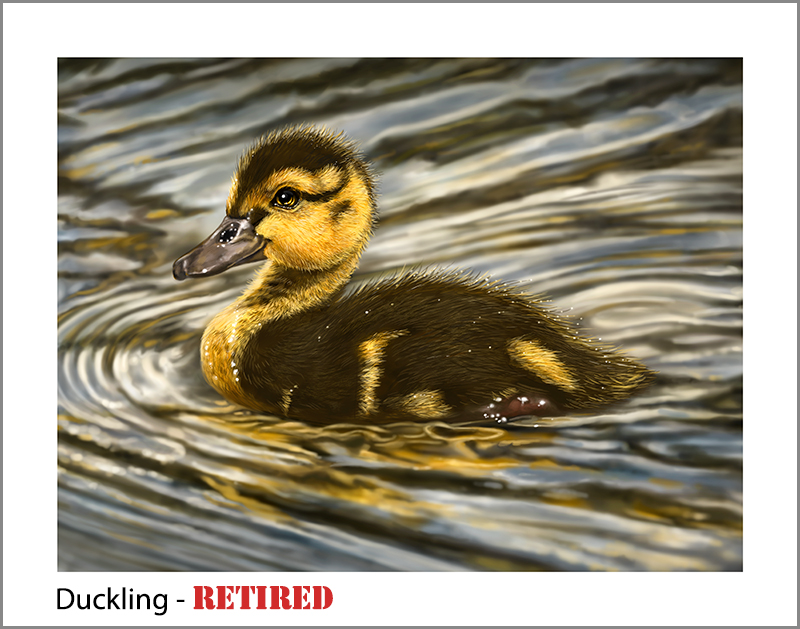 I never know which paintings will become popular and which ones won’t resonate with people. Or sometimes people will like an image, just not as a print to hang on their wall. The only way to find out is to create the painting, release it, and see what happens. When I retire an image in print, it means it will no longer be available on my site or at markets.
I never know which paintings will become popular and which ones won’t resonate with people. Or sometimes people will like an image, just not as a print to hang on their wall. The only way to find out is to create the painting, release it, and see what happens. When I retire an image in print, it means it will no longer be available on my site or at markets.
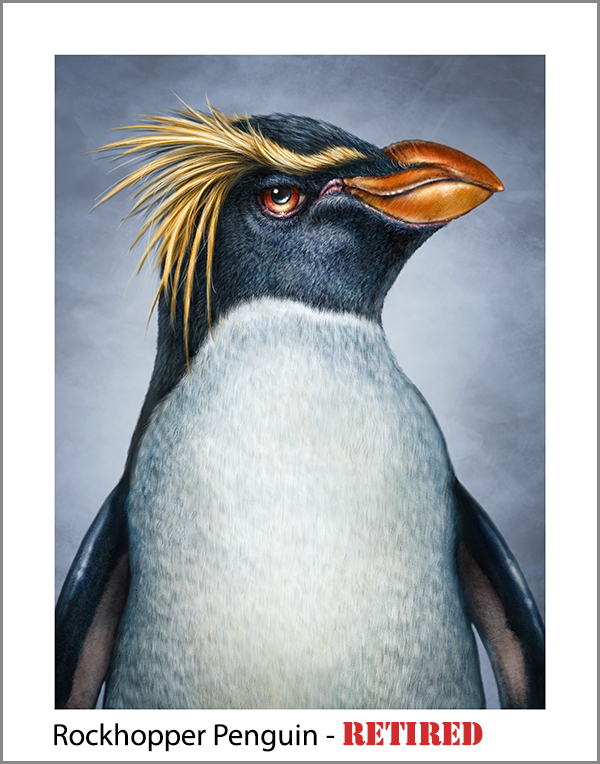 Sometimes, a print will become popular for a particular venue, like the Calgary Zoo. My Rockhopper Penguin does very well for them because they have a penguin habitat their visitors enjoy. But that print has never done well for me at markets or the Calgary Expo.
Sometimes, a print will become popular for a particular venue, like the Calgary Zoo. My Rockhopper Penguin does very well for them because they have a penguin habitat their visitors enjoy. But that print has never done well for me at markets or the Calgary Expo.
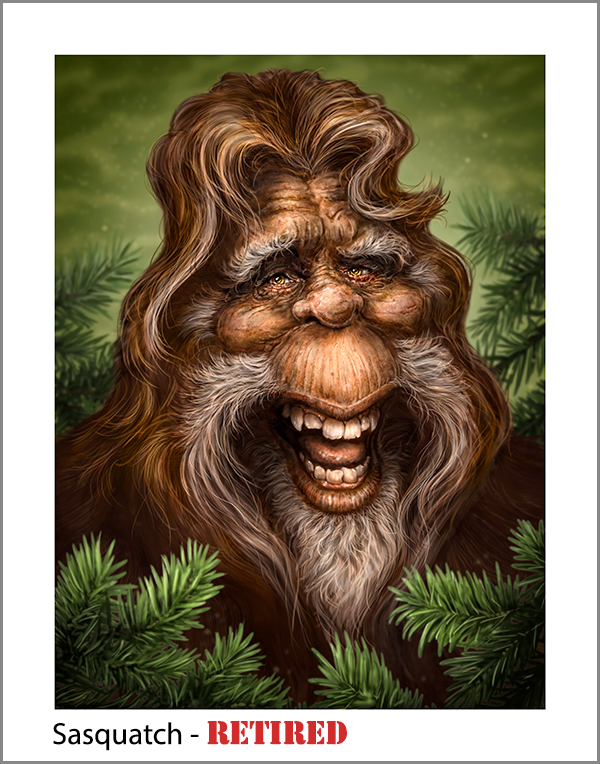 My Sasquatch painting is a popular licensed image for Pacific Music & Art, as they have customers all over the Pacific Northwest, BC, and Alaska. Harlequin Nature Graphics sells the image on T-shirts and has been a good seller for them for years. And while I have sold several prints of that image, it’s never been a bestseller for me.
My Sasquatch painting is a popular licensed image for Pacific Music & Art, as they have customers all over the Pacific Northwest, BC, and Alaska. Harlequin Nature Graphics sells the image on T-shirts and has been a good seller for them for years. And while I have sold several prints of that image, it’s never been a bestseller for me.
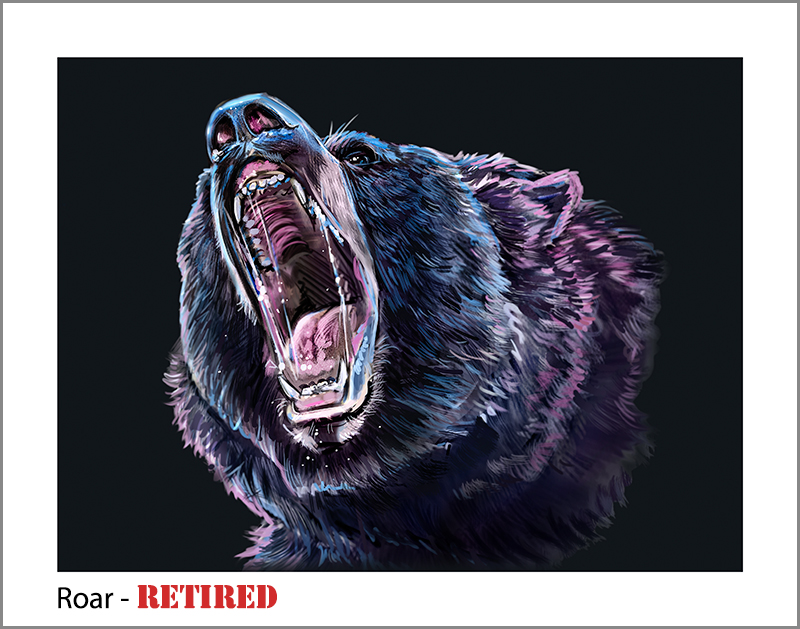
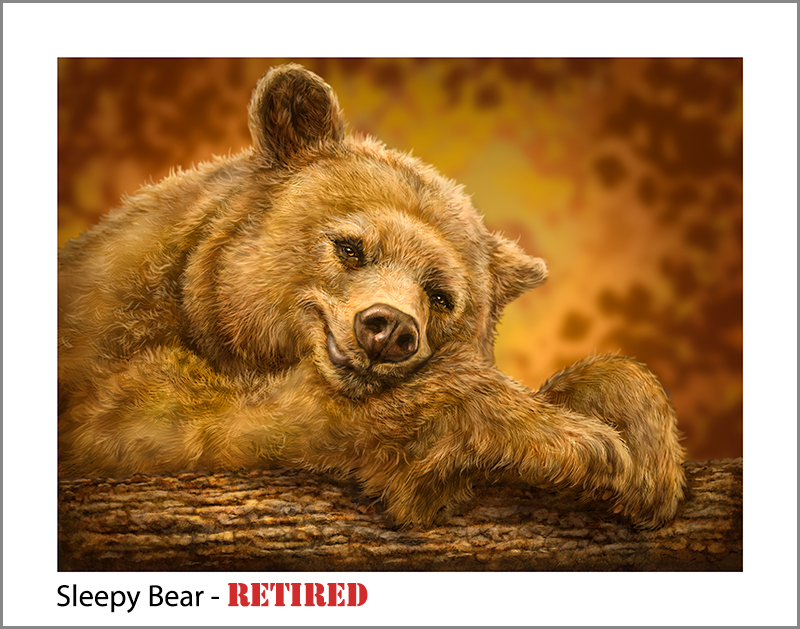 Art Ink Print in Victoria has been professionally printing my work for years, but they’re a small business, too. They require a minimum order for each image, or it isn’t worth their time. If I continued to stock several different prints that don’t sell well for me, it would cost me more than I would make to keep them in stock to have them on hand for the one or two that might sell at each market or online.
Art Ink Print in Victoria has been professionally printing my work for years, but they’re a small business, too. They require a minimum order for each image, or it isn’t worth their time. If I continued to stock several different prints that don’t sell well for me, it would cost me more than I would make to keep them in stock to have them on hand for the one or two that might sell at each market or online.
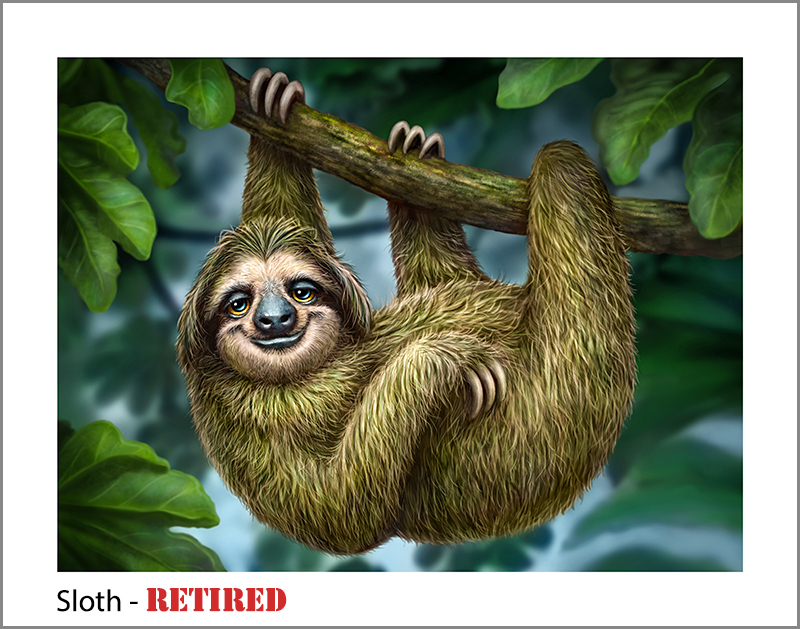 Even when I no longer sell a print, my licensing clients may still offer the image on their products, and my wholesale customers may still order prints from me to sell to their customers. I just have to require the same minimum orders from them that my printer requires from me.
Even when I no longer sell a print, my licensing clients may still offer the image on their products, and my wholesale customers may still order prints from me to sell to their customers. I just have to require the same minimum orders from them that my printer requires from me.
It’s tough to retire prints. I’ve spent many hours on each painting and get attached to each one. This little rat has always been one of my favourites. But when your art pays your bills, you’ve got to make tough choices.
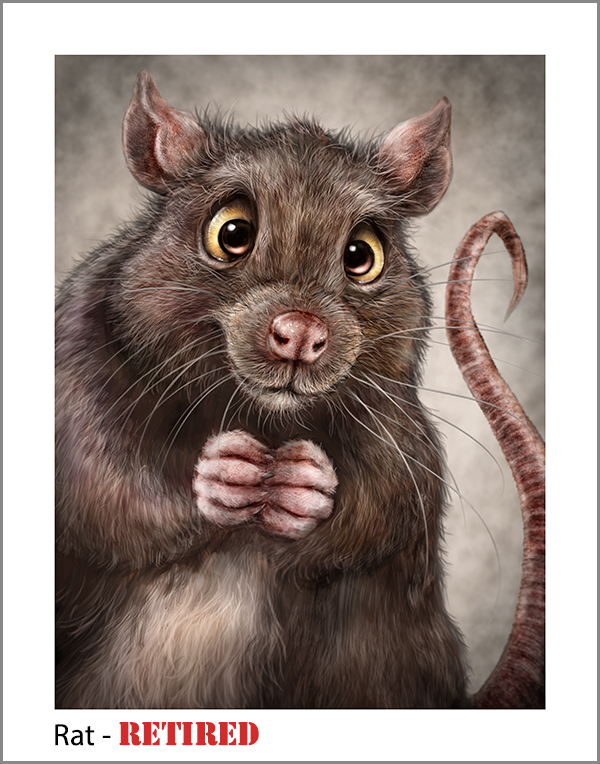 My next-door neighbours, Noble Coin Rings out of Innisfail, are fun to work with. I was beside them last year for my two weekends at this show, and the organizers put us together for four weeks at this one. They also do the Calgary Expo.
My next-door neighbours, Noble Coin Rings out of Innisfail, are fun to work with. I was beside them last year for my two weekends at this show, and the organizers put us together for four weeks at this one. They also do the Calgary Expo.
We get along well; there are plenty of inside jokes, inappropriate comments and smartass exchanges. We’ve each requested the same spots for next year and the same neighbours. It would be hilariously perfect if we found ourselves next to each other at the Calgary Expo in the spring, but it’s unlikely at such a big show.
One of the things that has affected public perception of my work lately is how much AI has suddenly become a part of our lives, especially for creative professionals. Once these markets are over, I will focus on finishing two paintings before the end of the year. After that, however, I’m planning a video to talk about artists having to adapt to this new technology.
The first time somebody asked if my work was AI was at last year’s Banff Christmas Market, and it surprised me, though it probably shouldn’t have. For years, one of my lines while introducing my work has been, “No photos are part of my work. I only use them for reference.”
In the early days of my career, many assumed that if you were drawing or painting on a computer, you must be manipulating photos and using filter effects. I used to get my hackles up, bite back the bile, and explain that I don’t do that. Each painting begins on a blank digital canvas and involves many hours of brushwork.
Because enough people are asking at this market, I now must add, “No photos or AI are part of my work.”
A great part of the personality of the Banff Christmas Market is the atmosphere they’ve created. It’s like a little Christmas village, with decorations everywhere. Families can book photos with Santa; there’s live music in the courtyard, woodburning fires with blankets, plenty of seating, games, and entertainment. They’ve also set up several creative photo opportunities. And if all that wasn’t enough, trains fly by several times a day, gently shaking the building.
I’m not big on Christmas, but this atmosphere softens even my crusty Scrooge exterior.
Which brings me to the Banff Christmas Market Grinch.
This character roams the show in great makeup and costume, posing for photos. Whoever plays this role owns it and is doing a great job. He’s fun, delightfully nasty, and has a quick wit.
On Saturday, he was going from booth to booth in our part of the show, loudly cackling his insults, impossible to ignore. At some point, I had turned my back to my booth while talking with my neighbours, so I missed him walking up and looking at my artwork.
Suddenly, behind me, the Grinch loudly said, “Wow, AI has really come a long way.”
As if poked with a sharp stick, I spun on my heels and snapped, “Hey, these are NOT AI!”
My neighbours began laughing, and I immediately knew I’d been baited and caught. Like any good comedian who realizes he’s pressed the right button, he took it up a notch. He loudly announced to everybody within earshot, “Attention. I need everybody’s attention. I have an announcement. Pat-a-rique (deliberately mispronounced) is not using AI. Because Pat-a-rique is AN ARTISTE!”
The rest was a blur. I just stood there, blushing, laughing, and taking it. After a few weeks of too many people asking if my work is AI and calmly explaining through clenched teeth that it’s not, he had struck a very raw nerve.
You’re a mean one, Mr. Grinch. But damn, it was funny.
Shonna finally got to visit the market on Sunday. She approached my booth and asked, “Are these AI?”
It’s a good thing she’s cute.
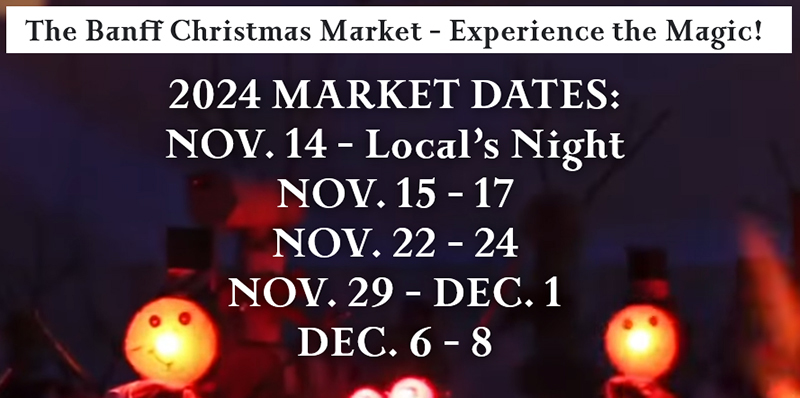 There’s one more weekend to go. Though I have sold out of some prints, I still have a wide selection of metal, canvas and poster prints, magnets, postcard sets and coasters. And my calendars and Highland Cow magnets have finally arrived. I’m feeling much better and look forward to seeing more familiar faces and meeting new ones.
There’s one more weekend to go. Though I have sold out of some prints, I still have a wide selection of metal, canvas and poster prints, magnets, postcard sets and coasters. And my calendars and Highland Cow magnets have finally arrived. I’m feeling much better and look forward to seeing more familiar faces and meeting new ones.
And if you hurry, you might just see a whimsical wildlife painter (it’s NOT AI!) revealing the tiniest bit of Christmas spirit.
Bah, Ho, Ho, Ho,
Patrick

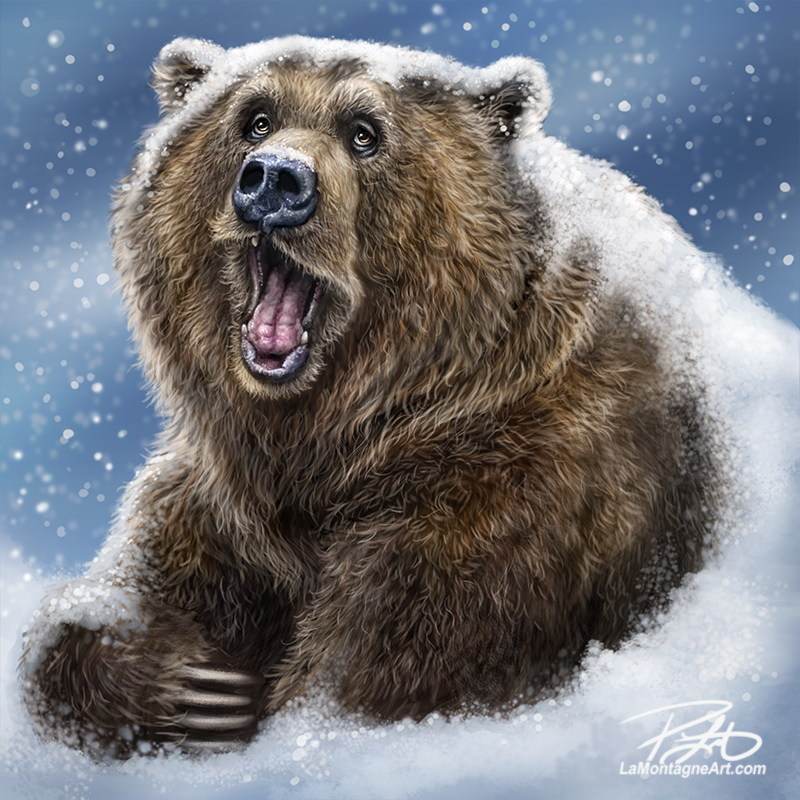 Because I haven’t released a new painting in a while, I did not want to publish yet another post promising something new down the road. So, here’s a new piece: a weary-looking grizzly bear in the snow. I’m calling it Bedtime.
Because I haven’t released a new painting in a while, I did not want to publish yet another post promising something new down the road. So, here’s a new piece: a weary-looking grizzly bear in the snow. I’m calling it Bedtime.
I had planned on sharing a different painting this week. Here’s why that changed.
Over the past twenty-plus years of my art career, both as a syndicated editorial cartoonist and a digital painter, there have been plenty of times when something I’ve drawn hasn’t worked out the way I had planned.
The beauty of digital drawing and painting is that it’s often easier to fix mistakes. I can create a new layer, play around and experiment; if I don’t like it, I delete it and try a different direction. Most creatives are familiar with happy accidents, something unexpected that improves an image. It happens all the time.
There’s always an element of discovery in any illustration or painting.
On the flip side, an image can sometimes become an exercise in frustration. Years ago, a bighorn sheep painting had me pulling out my hair. No matter what I did, I couldn’t get the curl of the horns to look right. They were either too flat, distorted, or just wrong, and every time I messed with them, I’d have to spend hours repainting the detailed texture I ruined.
It’s hardly a unique story. Every artist I know goes through this. For traditional artists who paint with oil, acrylic, watercolour or airbrush, it’s even worse. Sometimes, they try to fix something that isn’t working and get to a point where they’ve just ruined any chance of recovery. The canvas ends up in the trash, and they start over.
I began a painting of a group of Ring-tailed Lemurs months ago. I thought it would be finished this summer and again this week. I can’t begin to estimate how many hours I’ve spent on this painting. It has been one disappointment after another. But I finally got through the other work and deadlines holding up my progress and recently spent several mornings on it.
I was within what I thought was two or three hours of finishing, then realized I didn’t like it. That’s a hard truth to admit when I have invested so much time into a piece.
On my iPad, I took it to my buddy Derek at Electric Grizzly Tattoo. He’s a talented and skilled artist, and we sometimes ask each other for an unbiased eye. I can always count on his constructive criticism and willingness to help me produce a better piece of art. I do my best to return that generosity in kind, and when asked, offer my own thoughts on his paintings.
While Derek liked the individual faces, he agreed that the composition had problems. It was tough to hear, but it confirmed what I already knew.
After I got home, I spent a couple of hours messing with it, still trying to save it. But it was a gut-punch realization that I’d almost have to start from scratch. If I released the painting as is, knowing the obvious problems, even if others like it, I would hate it every time I looked at it.
So, while I’m not quite back at square one, it’s close. I’ve been sketching over the piece and trying new things, and I’m already much happier with the composition.
Reworking it, however, meant destroying what I had already painted. I must redo all the fur and hair, the detail in the muzzles and eyes, and add other elements that weren’t there before.
Whenever I finish the newer version, I will share more about this process, including what specifically I didn’t like and my thoughts on what I needed to change. I will also show you the piece I showed Derek and share why we both felt it didn’t work. But I don’t want to do that until I reveal the finished piece so you can see the comparison.
Anytime you do something creative, there’s a chance it won’t work. Authors have had to discard whole chapters and rehash plotlines when an editor has their way with a novel. Chefs have prepared complicated and ultimately inedible meals from experimental recipes. Filmmakers have spent years creating box office bombs.
As Benjamin Franklin said, “I didn’t fail the test; I just found 100 ways to do it wrong.”
If you’re not prepared to fail, you’ll never succeed.
So, I set the lemurs aside this week and began this bear piece on Tuesday as a palate cleanser before I jump back into the other works in progress I have yet to complete, including those lemurs.
Because when life hands you lemons, paint a grizzly bear.
That’s the saying, right?
Well, it works for me.
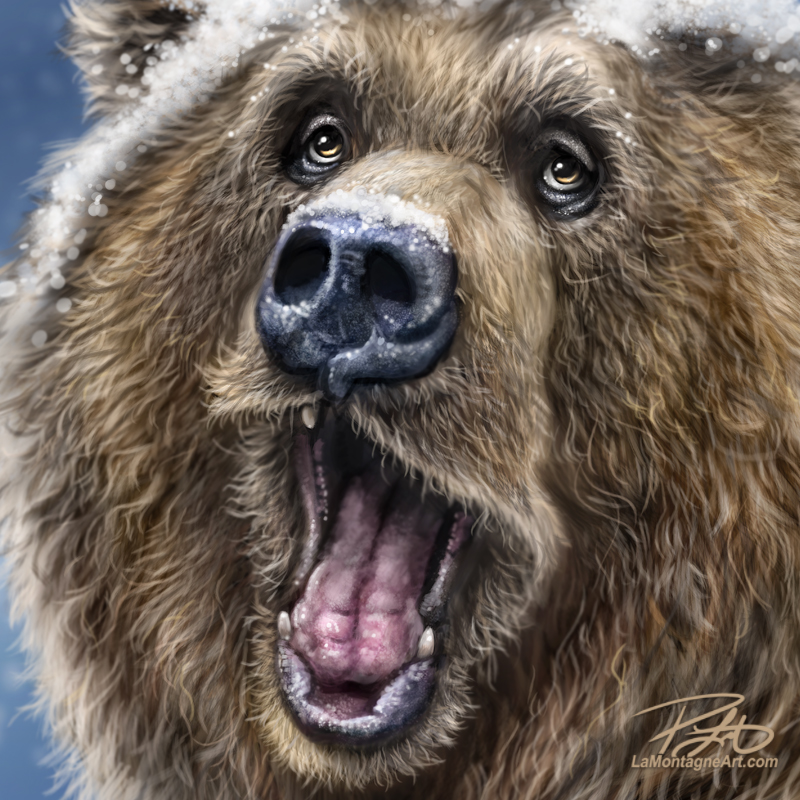
This Thursday, I’ll be one of 150 vendors setting up for the Banff Christmas Market. That evening, a locals’ preview event is already sold out. After that, from Friday to Sunday for the next four weeks, you’ll find me in my booth at the Banff Train Station, offering prints, calendars, coasters, magnets and stickers. Tickets are only available in advance on their website, and they go quickly, especially on Saturdays. I hope to see you there.
Thanks to so many of you who have purchased calendars already. I’ve been getting those orders out as soon as they come in, so if you’re waiting for yours, they’re on the way. If you still want one (or two, three, four…you get the idea), you can get them in the store while supplies last.
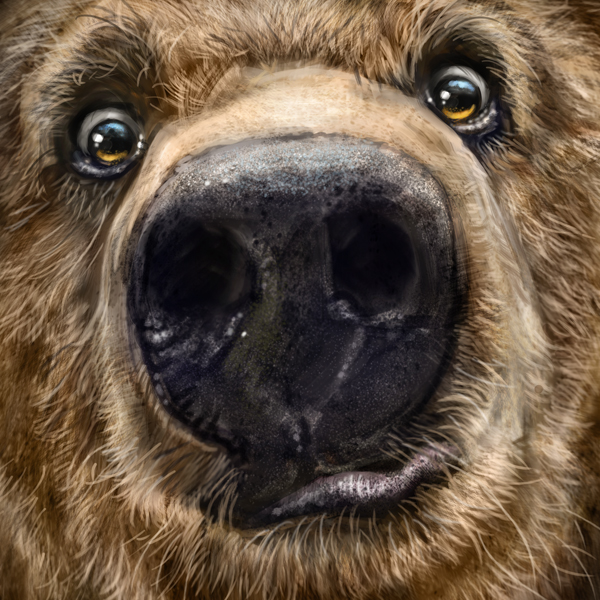
 With a website and email list, keeping up with regular posts is important, especially when there’s an implied promise to anyone who subscribes.
With a website and email list, keeping up with regular posts is important, especially when there’s an implied promise to anyone who subscribes.
But what if it’s been weeks, and I haven’t got any new work to share? Or what if I’ve got nothing upbeat and positive to write about? Everybody talks about the value of authenticity, but when you’re struggling with unrealized expectations and unmet goals, is it better to go a month without posting, or do you bare it all and risk the unsubscribes from people who just want to see another funny-looking animal painting?
It’s amazing how often people think art-for-a-living is drawing and colouring all day. I spend more time on business activities surrounding the art than I ever do creating it, as do most creatives I know. Knowing that reality ahead of time is essential if you’re ever considering this profession.
It has become clear that I’ve bitten off more than I can chew this year. I began 2024 with big plans and projects and feel I’ve mostly failed. I work long hours almost every day, but I’m not getting enough done.
The editorial cartoon work can be incredibly frustrating as those deadlines always take priority over the painted work, even though it’s the side of my business with no chance of increasing revenue. Newspapers aren’t about to bounce back.
So the first weekly task, beginning Sunday morning, is to get five syndicated cartoons done before Wednesday for my daily and weekly newspaper clients and one local exclusive cartoon done for Tuesday evening for the Rocky Mountain Outlook. Then, if breaking news doesn’t disrupt the schedule, I can work on administrative work like invoicing, print packaging and shipping, promotional material, writing, and hopefully painting.
I wanted at least two new puzzles for the Banff Christmas Market this year. But because I needed to finish two very involved paintings that still aren’t done, that won’t happen. There’s a long lead time to have them printed and packaged, and I missed that deadline.
Puzzles come with a significant initial expense, and I had to ask myself if I needed to spend more when I already have plenty invested in other stock.
I drove into the city on Sunday morning to drop off a large print and sticker order to the Calgary Zoo. Usually, that’s an opportunity to take reference photos, but with no extra time, I didn’t go beyond the gift shop. After a quick detour to Costco, I was back at my desk drawing cartoons by early afternoon.
Because of the work that goes into selling and marketing my art, with the runup to the Banff Christmas Market, I’m not getting enough painting done, and I don’t know how to solve this problem.
From early November until mid-December, there won’t be any time off. I’ll be at my booth at the Christmas Market from Friday to Sunday every weekend. From Monday to Thursday, I’ll be drawing editorial cartoons, packaging and shipping orders, and the usual admin work, plus the extra with a gift show. That doesn’t leave time for painting.
I’m trying to keep the proper perspective on this. I still have 50 animal paintings available in prints. That’s more than enough for the upcoming market. Though I wanted some paintings in progress finished for this event, I don’t need them. Those I added earlier this year for the Calgary Expo will still be new to people at this venue.
I did two weekends for the first time at the Banff Christmas Market last year. This year, I’m doing four. Unlike at the Calgary Expo, I don’t yet have a following at this event. That means my classic and bestselling paintings are still new to this audience. I will meet plenty of people who have never seen my Smiling Tiger, Otter, Winter Wolf or the grinning gallery of grizzly bears.
I need to retire some paintings in my current catalogue. When you put too many choices in front of people, it gets overwhelming. My printer in Victoria has minimum order requirements, so if I only sell two of an average selling image at Christmas, that costs me more than I made because of how many I had to order.
Art-for-a-living is a business and requires difficult choices. When a painting is no longer popular, it’s time to let it go in favour of testing the waters with new work.
In the past, I’ve put prints in the store as soon as I painted them. In 2025, I will only do print releases twice a year. This will hopefully allow me to get several paintings done, build anticipation, and have a bunch of new releases to promote before the Calgary Expo in the spring and the holiday season in the fall.
It also means I can build new art collections for potential licensing rather than offer new paintings individually. Licensing revenue hasn’t been as reliable as I’d like this year, and it is even down for some clients.
Even with non-exclusive licenses, many companies don’t want to offer the same paintings on the same type of products. So, when images are already spoken for, they’re less likely to attract new clients.
To solicit new contracts, I need to offer them new paintings.
En route to Thanksgiving dinner with family this coming weekend, we’ll detour to Discovery Wildlife Park to drop off a print order, but there won’t be time for a visit there, either. Thankfully, I do have a cabin trip coming up for a weekend break before the holiday frenzy begins.
Then, I’ll get my flu and COVID shots to do my best to stay healthy for the rest of the year. I have a recurring worry that I’ll get sick for one of the market weekends, and my booth will sit empty.
In silver lining news, because of the large print orders I just filled for the Calgary Zoo and Discovery Wildlife Park, and not wanting to leave anything until the last minute, all my prints have arrived for the rest of the year. The online store is fully stocked with prints, stickers and postcard sets. I am still waiting on calendars.
If you haven’t checked out the store for a while, please do, as I’ll retire many of these after they sell at the Banff Christmas Market. Don’t miss out on what might be your favourite. My prints are 11×14, an easy-to-find frame size wherever you buy yours. It’s never too early to start thinking about office gift exchanges or spreading happy animal art around to your friends and family.
As for sharing new work, I won’t promise anything right now for fear I won’t be able to deliver. All I can do is ask for your patience. There’s nobody who wants to see more finished work than me.
Cheers,
Patrick

About a month ago, Shonna was able to take a couple of days off, and we drove to Red Deer to see our parents and spend a little time at Discovery Wildlife Park. A scorching and bright sunny day, less than ideal for photos; we only spent a couple of hours at the park. But we got to visit with our friend, Serena, and meet the baby orphaned raccoon she was looking after.
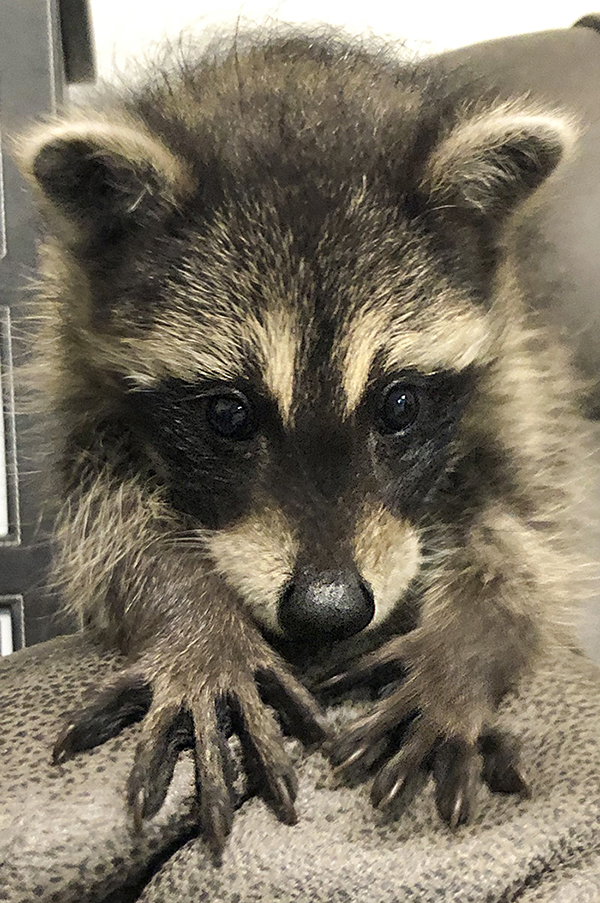 Despite the bright sun, I got some shots of the two black bear cubs. There might be inspiration for a painting or two in the few photos I kept, but I will let them simmer and review them in a few months. My mood and circumstances can colour my perception, so shots that don’t inspire me in August might push the right buttons in January.
Despite the bright sun, I got some shots of the two black bear cubs. There might be inspiration for a painting or two in the few photos I kept, but I will let them simmer and review them in a few months. My mood and circumstances can colour my perception, so shots that don’t inspire me in August might push the right buttons in January.
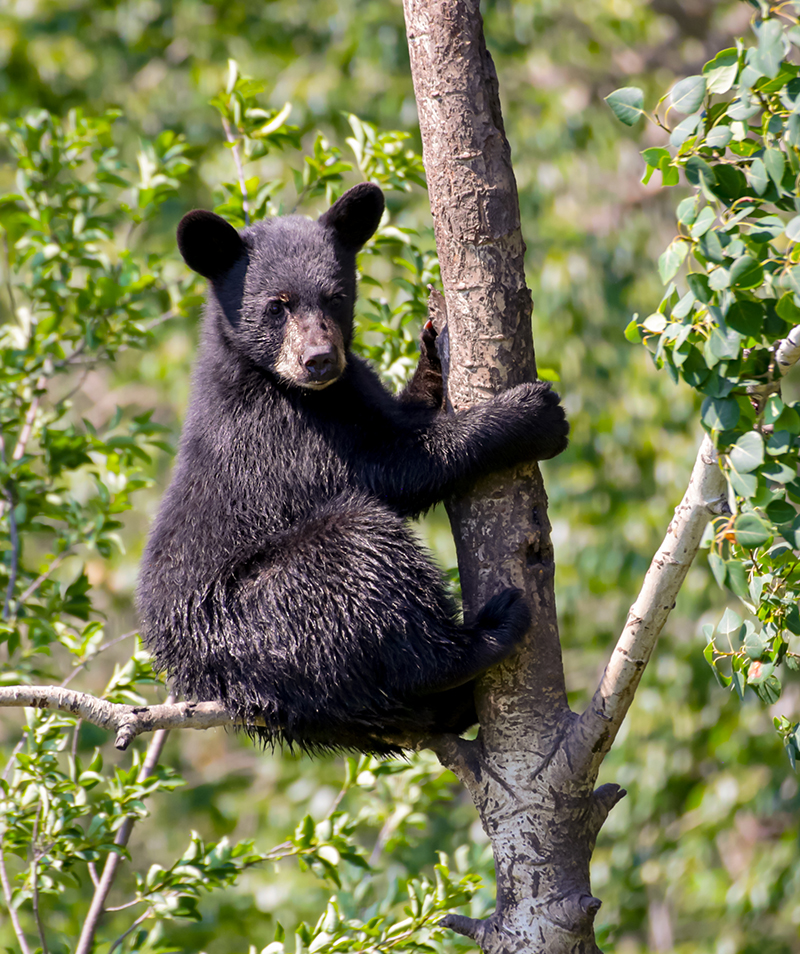 Although I prefer to take my own reference photos whenever possible, I am not interested in becoming a professional photographer. Connecting the dots between aperture, shutter speed and ISO and understanding how they work together, it just seems like math and bores the hell out of me.
Although I prefer to take my own reference photos whenever possible, I am not interested in becoming a professional photographer. Connecting the dots between aperture, shutter speed and ISO and understanding how they work together, it just seems like math and bores the hell out of me.
I’ve read plenty of books, watched videos and taken classes, but I’ve never got ‘the hook,’ that thing where you connect to something on a level that makes you want to pour all your energy into becoming better at it.
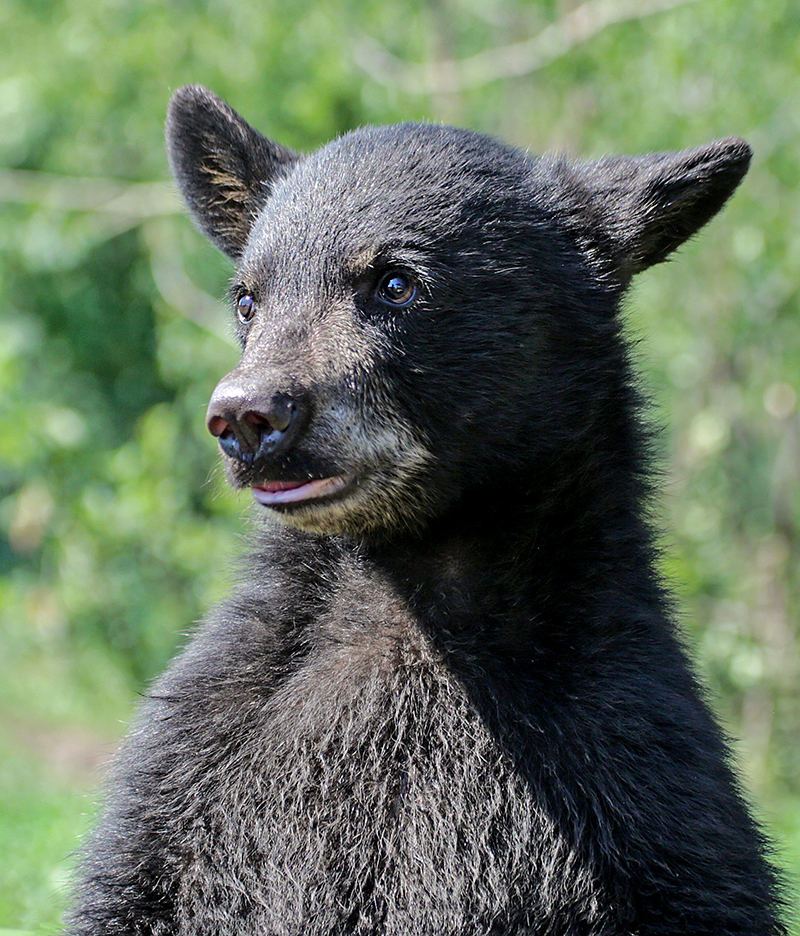 I know that hook because I have it for drawing and painting. I can spend hours detailing little hairs or working to get the texture of a bear’s nose just right. I am confident that would be incredibly dull for most people.
I know that hook because I have it for drawing and painting. I can spend hours detailing little hairs or working to get the texture of a bear’s nose just right. I am confident that would be incredibly dull for most people.
I admire plenty of photographers whose artistic skills inspire and baffle me. The art they create and capture is impressive. But when I see their work, I don’t think, “I want to do that!”
What I do think is, “I want to see a coastal grizzly walking out of a Vancouver Island rainforest!” or “Yeah, that’s a beautiful shot of a bald eagle grabbing a salmon, but I’m gonna need a closer zoom of that face to see her expression.”
I love the experience of taking photos, especially when it involves critter faces. I paint personality in my images because that’s what I see. I instinctually imagine animals as characters, and the twitch of a lip or crease in an eye ridge suddenly becomes an anthropomorphized expression I can exaggerate.
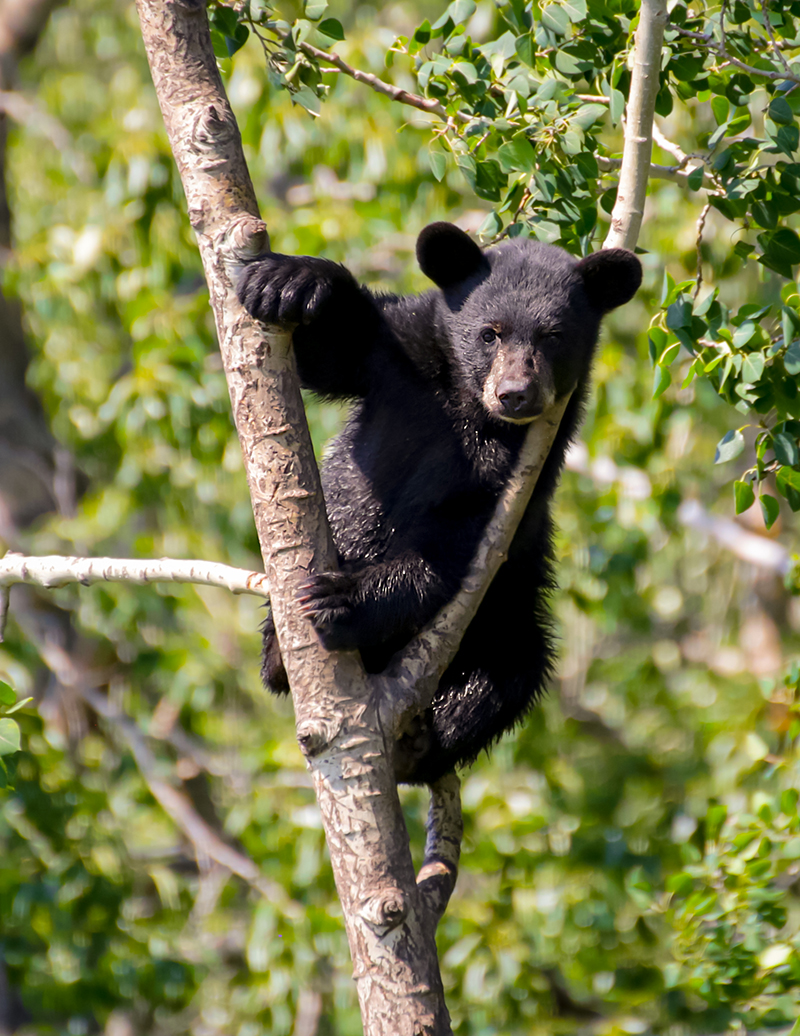 So, while I revel in learning a photography trick or technique that helps me take better reference, like David DuChemin’s tip this winter that allowed me to capture much better detail shooting ravens in the snow, I’m always thinking about the painting.
So, while I revel in learning a photography trick or technique that helps me take better reference, like David DuChemin’s tip this winter that allowed me to capture much better detail shooting ravens in the snow, I’m always thinking about the painting.
If I take a photo where the light isn’t great, and I can’t fix it well enough in Photoshop, a picture that would easily be in the discard pile for a professional photographer might still inspire a painting. My Smiling Tiger is a bestselling image, and I based it on a blurry, grainy reference photo I captured at The Calgary Zoo. Any self-respecting photographer would have deleted it on the first pass.
While I consider taking photos an integral part of my creative pipeline, that’s only the beginning.
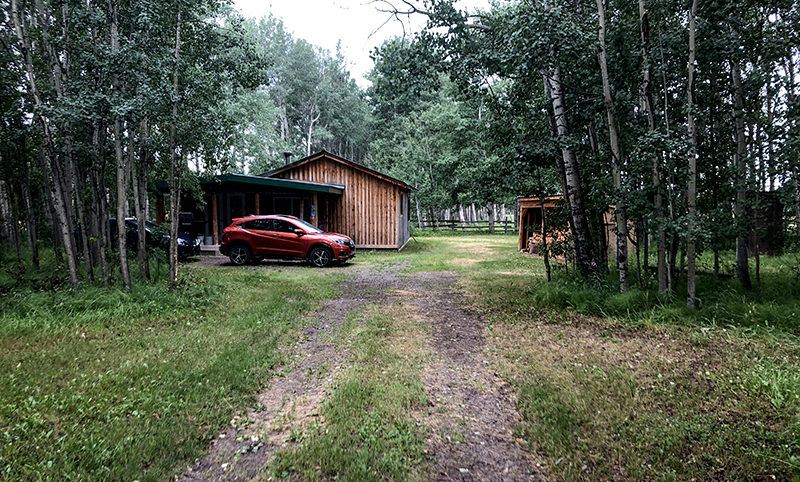 At the end of July, on the day I sent my last post, I headed to the cabin north of here with my friend, Darrel. With my current workload, time off hasn’t been a priority, so leaving for a few days felt irresponsible, but we had booked it months ago and paid our deposit.
At the end of July, on the day I sent my last post, I headed to the cabin north of here with my friend, Darrel. With my current workload, time off hasn’t been a priority, so leaving for a few days felt irresponsible, but we had booked it months ago and paid our deposit.
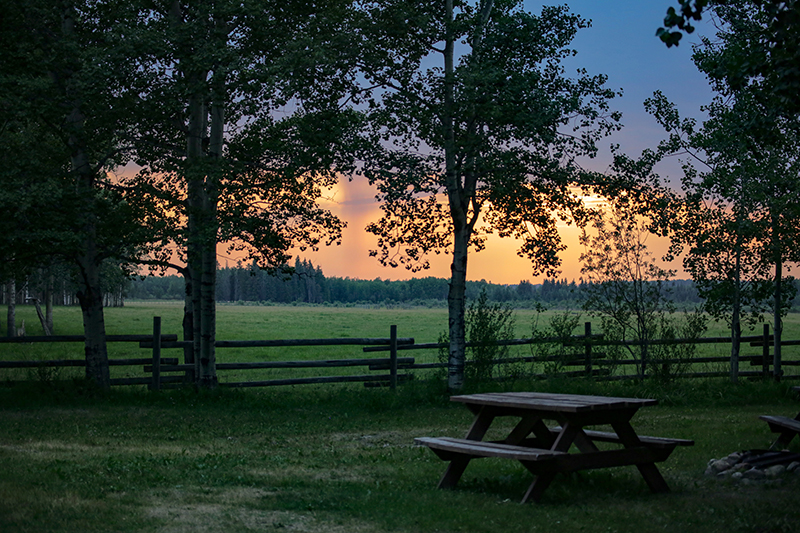 Though most of Alberta had been dealing with heavy wildfire smoke that week, it completely cleared up by the time I got to the cabin and stayed that way the whole four days we were there. The temperature even dropped to a comfortable level and we got some welcome rain. In fact, on the first night, it cooled off so much that we wondered if we might need a fire in the wood stove. Given the oppressive heat we’d just escaped, we had no appetite for that. But wearing long pants and a hoodie seemed strange that evening, given how uncomfortable the past month had been.
Though most of Alberta had been dealing with heavy wildfire smoke that week, it completely cleared up by the time I got to the cabin and stayed that way the whole four days we were there. The temperature even dropped to a comfortable level and we got some welcome rain. In fact, on the first night, it cooled off so much that we wondered if we might need a fire in the wood stove. Given the oppressive heat we’d just escaped, we had no appetite for that. But wearing long pants and a hoodie seemed strange that evening, given how uncomfortable the past month had been.
With the developing situation in Jasper, evacuees finding out that 30% of their town had burned down, it was impossible to completely relax or shut off the news. The weather reports warned of the potential for tornadoes and violent storms in our area due to the rapidly changing temperatures. Thankfully, those never materialized, but it still meant keeping one eye on the phone.
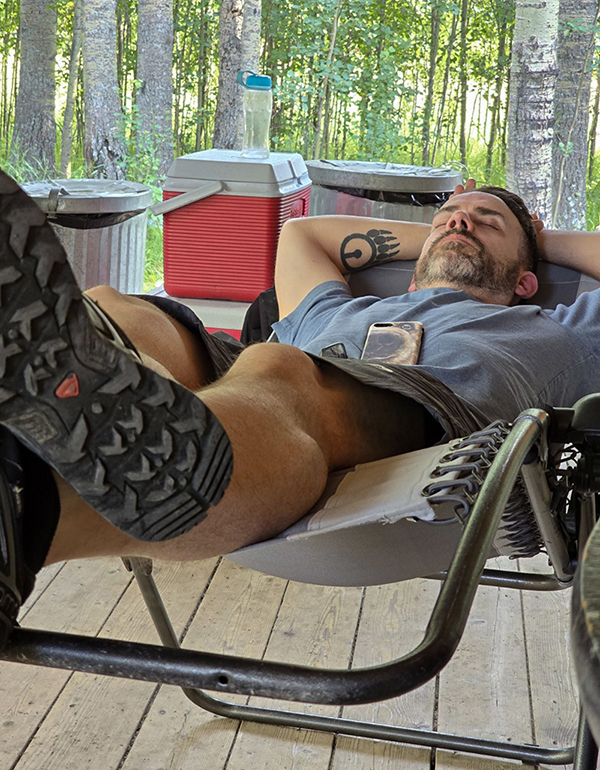 Even though I couldn’t turn off my busy brain, it was good to get away. We did what we always do: sat around talking, napped on the decks in the afternoon, walked around the large property, and played guitar, cards and Scrabble. Yes, we’re boring old men.
Even though I couldn’t turn off my busy brain, it was good to get away. We did what we always do: sat around talking, napped on the decks in the afternoon, walked around the large property, and played guitar, cards and Scrabble. Yes, we’re boring old men.
While I slept well the first couple of nights, I had bad dreams the last two. On the third morning, I woke up from one about 5:30 and tried and failed to go back to sleep. Darrel and I are both early risers, and while I’m up before then most days at home, I like to sleep a couple of hours longer at the cabin. So, I wasn’t impressed.
Though we have separate bedrooms, it’s a small cabin, and I didn’t want to risk ruining Darrel’s sleep by moving about that early. I quietly dressed, grabbed my camera and crept out the back door for a walk.
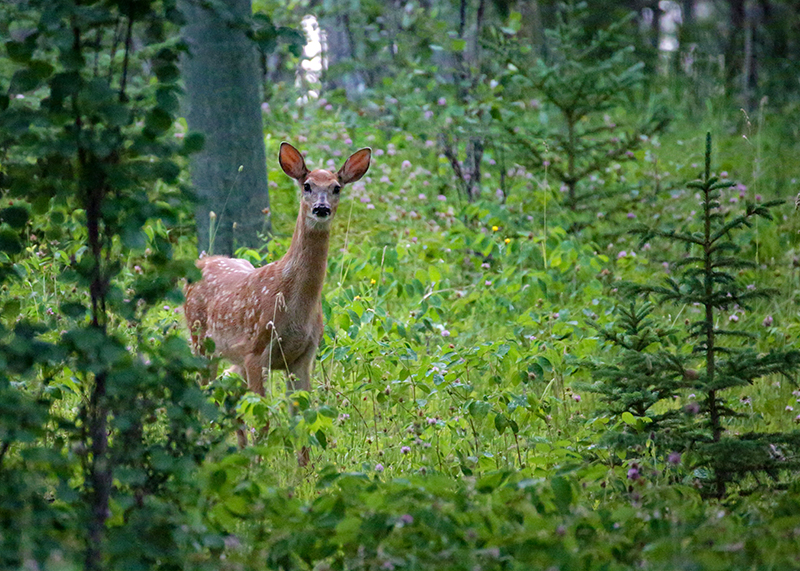 It was a very pretty and delightfully cool morning, and I knew there would be plenty of time to nap on the deck later in the day, so my mood improved. I wandered up the road, spooked a few deer and watched them take off across the neighbour’s newly cut and bailed hayfield. I kept my eyes peeled for other wildlife, hoping for an owl or coyote.
It was a very pretty and delightfully cool morning, and I knew there would be plenty of time to nap on the deck later in the day, so my mood improved. I wandered up the road, spooked a few deer and watched them take off across the neighbour’s newly cut and bailed hayfield. I kept my eyes peeled for other wildlife, hoping for an owl or coyote.
At the top of the long dirt road is a treed area that falls away to forest on both sides. That time of morning, that section of road was dark and shaded. I briefly saw a long, little critter standing tall on its hind legs on the side of the road before it squealed and ran down the steep bank to the forest floor below. I don’t know the critter’s gender, but with a 50/50 shot, I’m going with she instead of it.
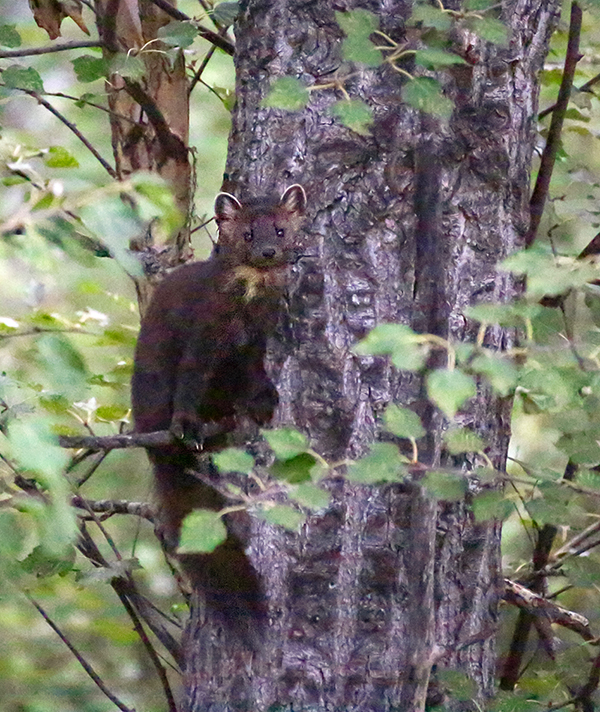 The base of the tree she ran up to escape was twenty feet below me down the steep bank, so her ‘safe height’ now put her at eye level with me as I stood on the road. And she was NOT happy about it.
The base of the tree she ran up to escape was twenty feet below me down the steep bank, so her ‘safe height’ now put her at eye level with me as I stood on the road. And she was NOT happy about it.
But I was thrilled, shooting pics of this sassy little pine marten as she grunted and squealed at me. She didn’t seem to know if she should climb higher or go back down. After a few back-and-forth scurries, with pauses to glare at me and curse my existence, she opted for down and made her escape.
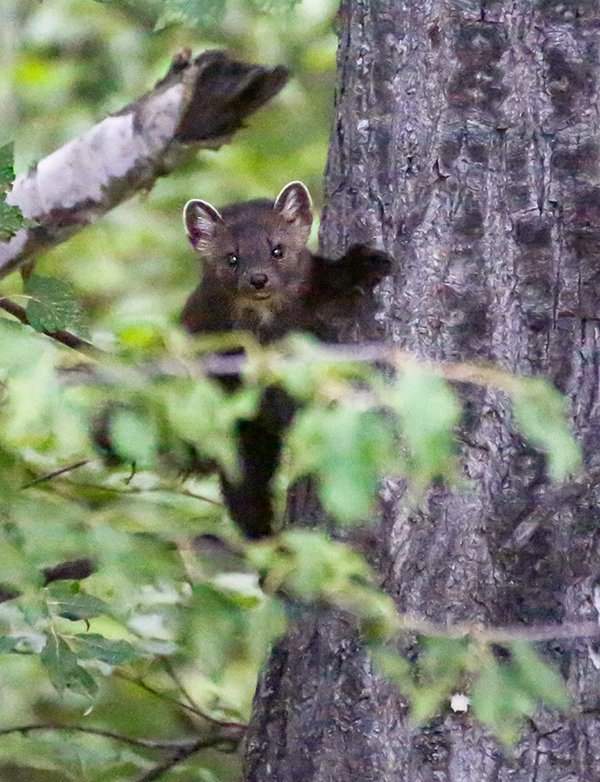 Though I had done what I could to boost my exposure compensation to account for the dark area in which I was shooting, I needed to keep the shutter speed high to try to capture this quick little marten. In the end, none of the pictures I got were very good, but I enjoyed the moment. I don’t know if I have ever seen a pine marten in the wild, but I was pleased with the early morning treat.
Though I had done what I could to boost my exposure compensation to account for the dark area in which I was shooting, I needed to keep the shutter speed high to try to capture this quick little marten. In the end, none of the pictures I got were very good, but I enjoyed the moment. I don’t know if I have ever seen a pine marten in the wild, but I was pleased with the early morning treat.
While the pics I got aren’t good enough for reference, I’ve added a pine marten to the list of animals I hope to encounter on future cabin visits.
I’m certain she feels differently.